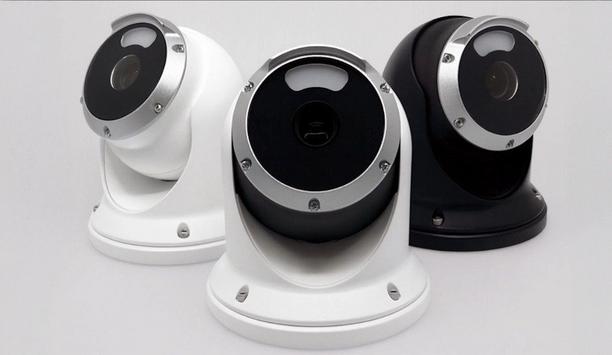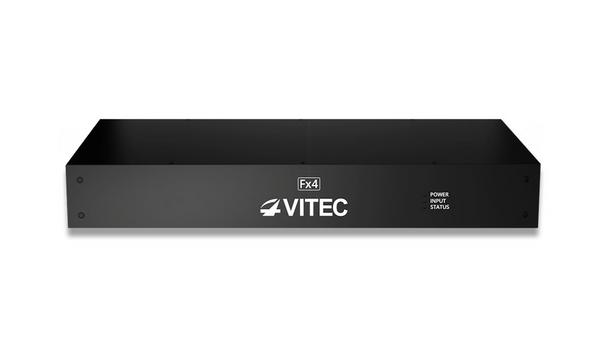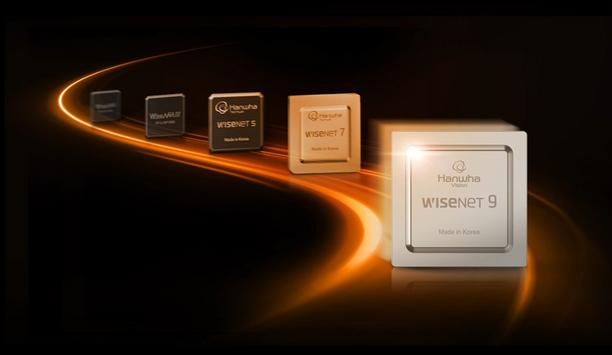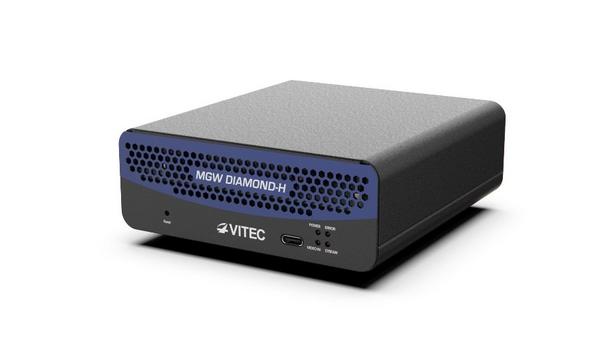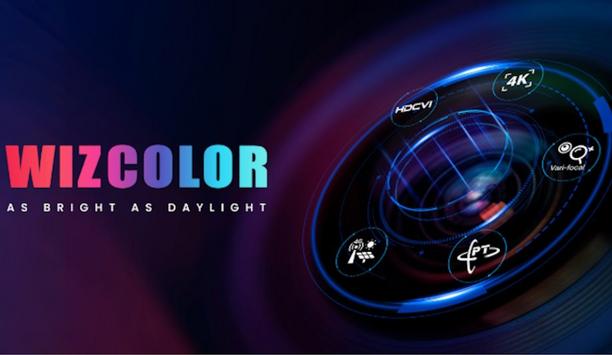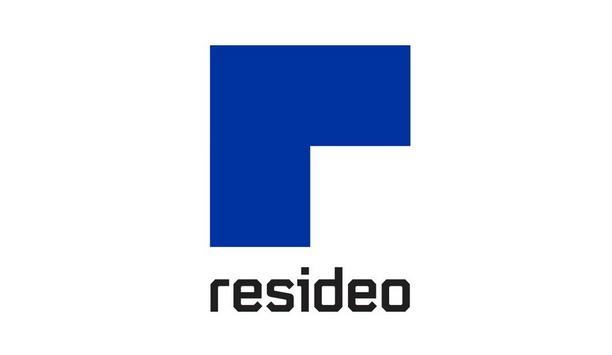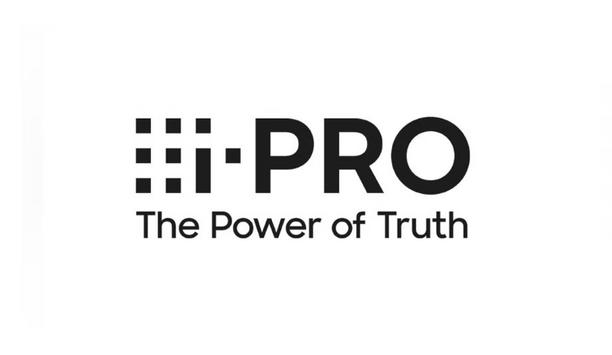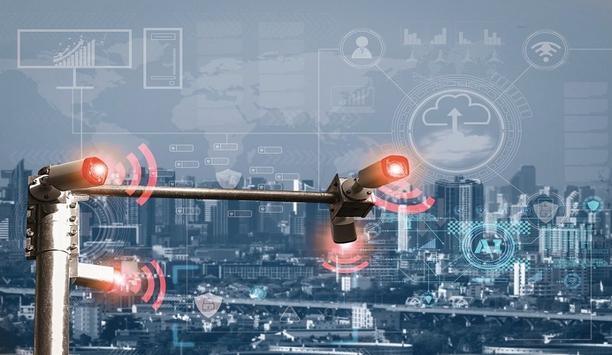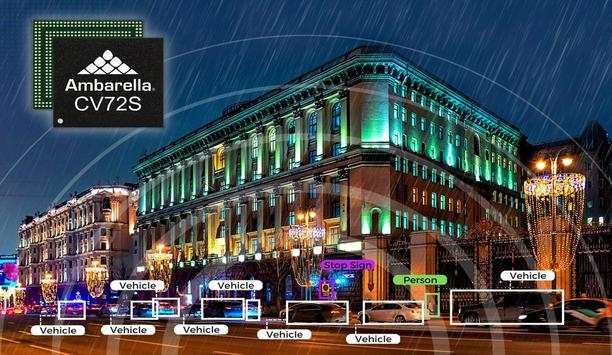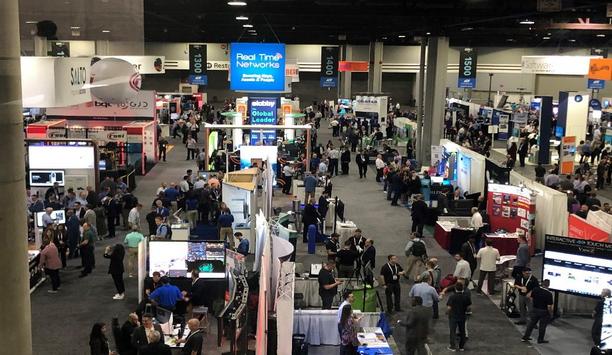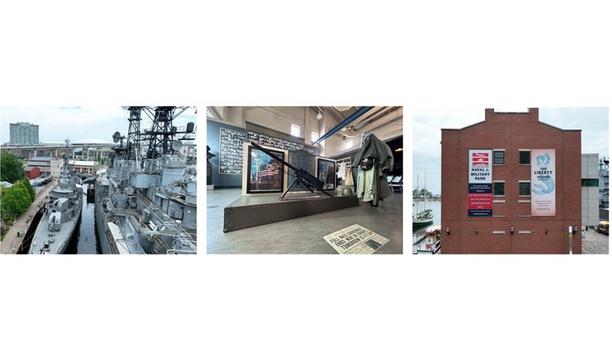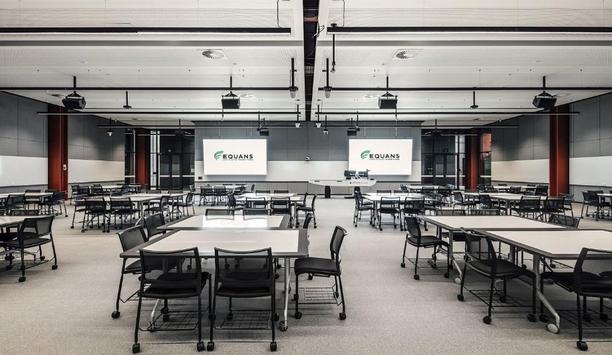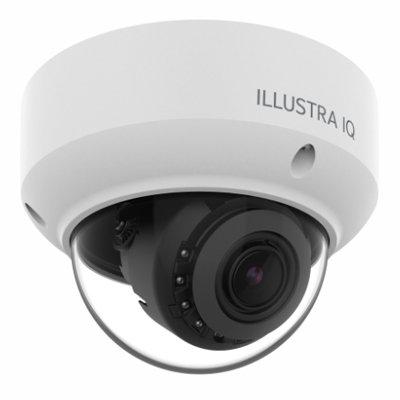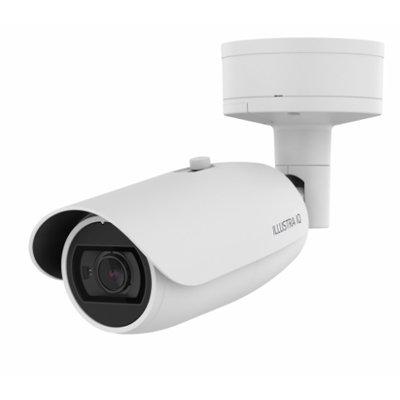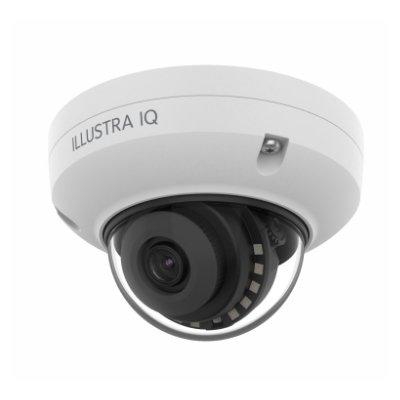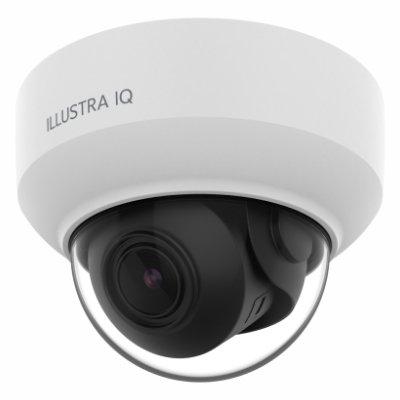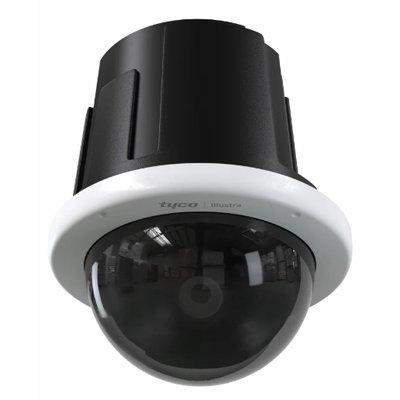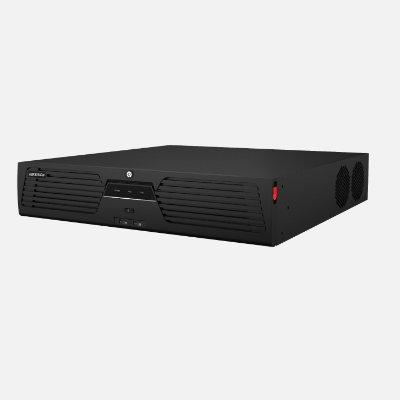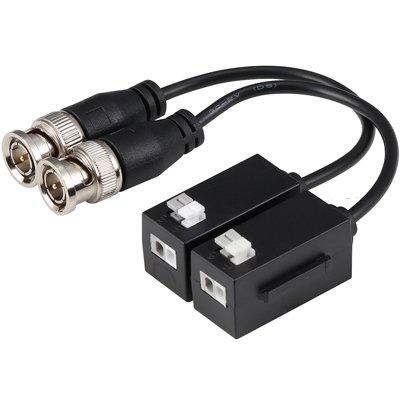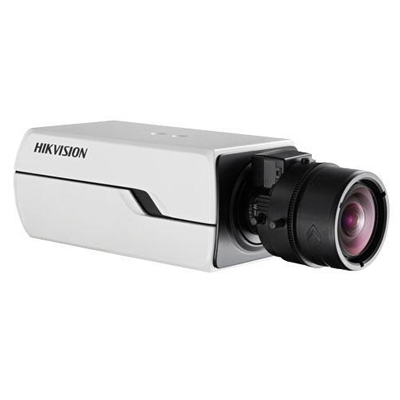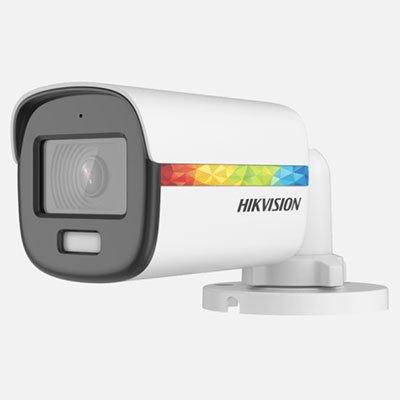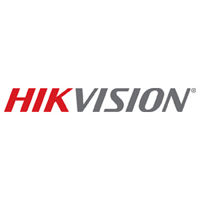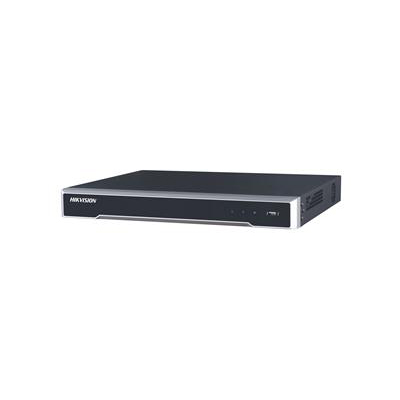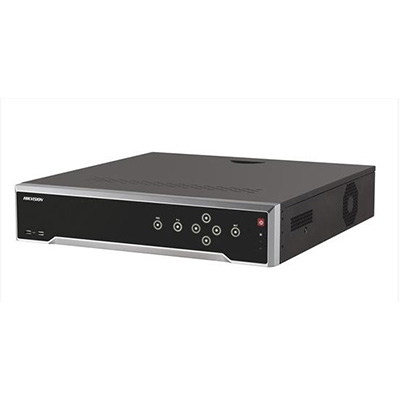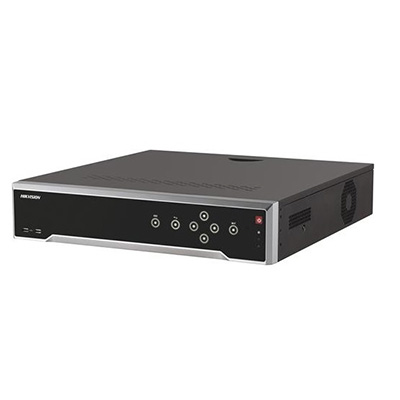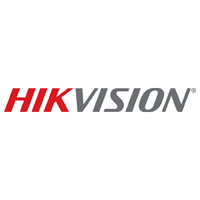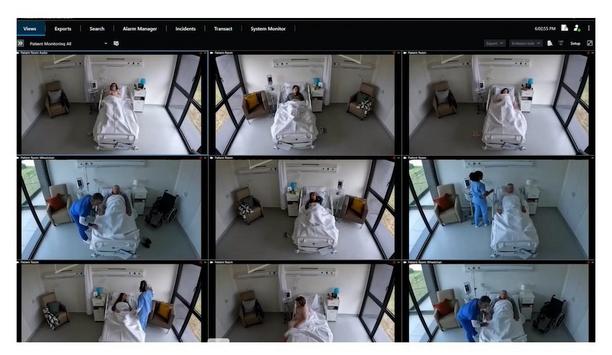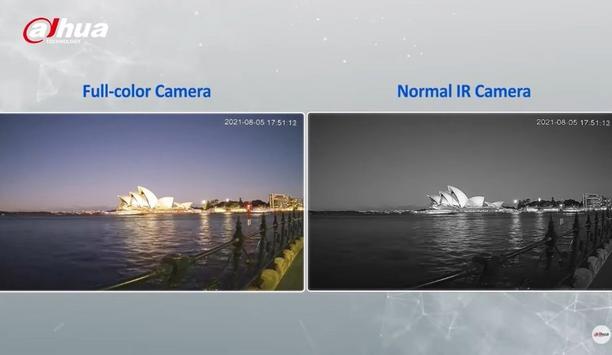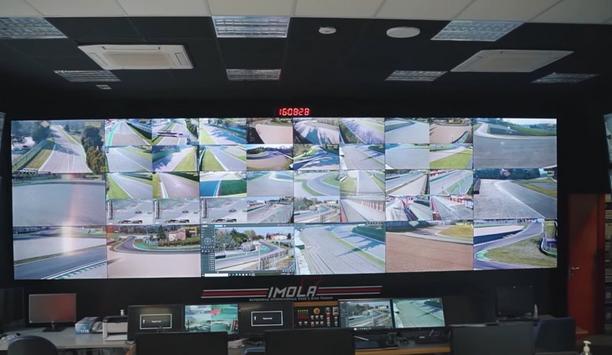4K
Iris Innovations, a world pioneer in specialized marine camera technology, has announced the launch of Photon, a compact ultra-low-light 4K night vision camera designed to make safe nighttime navigation accessible to every boater. Whether cruising after dusk, fishing before sunrise or patrolling remote coastlines, Photon delivers exceptional clarity and full-color imagery in near-total darkness – all without the need for infrared or thermal imaging. New benchmark for performance Unlike...
VITEC, a pioneer in Intelligence, Surveillance and Reconnaissance (ISR) video streaming solutions, will present its latest innovations at DSEI UK 2025, ExCel London, 9-12 September 2025. Visitors to stand S8-122 will experience the latest tactical video technologies, including the new VITEC Fx4 Series and VSN-Series video wall solutions. Also on show will be VITEC’s PRISM Transcoder, the TOUGH encoder family, and the MGW Diamond-H, all designed to meet the demands of the most challenging...
Ulticam IQ, a new line of AI-powered security cameras designed for advanced features and affordability from AIoT solutions pioneer Xthings, will now come with advanced cloud AI features using Gemini on Google Cloud, bringing professional-level video analytics to homeowners with free cloud recording on a rolling 7-day basis. This versatile indoor/outdoor camera combines free cloud storage, 4K Ultra HD resolution, and AI-driven features that provide human-like understanding of scenes and events,...
Hikvision introduces a powerful new AI-driven search capability aptly named AcuSeek. A new benchmark in video investigations and forensics, AcuSeek saves security professionals hours and makes it easier than ever to locate and queue captured video of specific people, vehicles, and key events simply by typing a description into a search bar. For example, to locate video of “a person in a red jacket carrying a backpack” or “a black SUV,” simply type the description...
When it comes to security cameras, the System on a Chip (SoC) is where the magic happens. It’s the brainpower packed into a tiny chip, handling everything from image processing to smart analytics. This combines multiple electronic functions into one super-efficient package. Advances in SoC have transformed security cameras, evolving them from bulky, inefficient systems to sleek, efficient devices. While many manufacturers rely on third-party general-purpose SoCs, Hanwha Vision ...
The physical security industry has been in love with the cloud for quite some time. And understandably so. The promise of instant scalability, centralized access, and simplified maintenance is hard to ignore, especially in an era of remote work and distributed facilities. But reality is catching up to the hype. For many, especially those dealing with video surveillance at scale, the cloud is no longer the catch-all solution it once seemed. Rising costs, bandwidth limitations, and latency issue...
News
VITEC, a prominent player in the Intelligence, Surveillance, and Reconnaissance (ISR) technology sector, is set to debut its advanced streaming technologies at DSEI Japan 2025, from 21-23 May 2025. This event marks VITEC’s first defense trade show appearance in the region, underscoring its expanding global footprint and commitment to delivering high-performance ISR video solutions worldwide. Located at booth H5-452, VITEC will feature its ruggedized TOUGH encoder family, designed for video acquisition in challenging environments, as well as its MGW Diamond-H, a 4K and Dual-Channel SD/HD HDMI Encoder. Additionally, EZ TV ISR, VITEC’s video content management solution engineered for rapid deployment in the field, will also be demonstrated. High-performance ISR video streaming “We’ve been carefully monitoring the progress of DSEI Japan as well as the Indo-Pacific market overall, and it’s an exciting time to exhibit our latest technologies in the region at this growing show,” states Jamie Hind, APAC Regional Director at VITEC. “VITEC is dedicated to providing dependable, secure, high-performance ISR video streaming solutions designed for the most demanding military settings.” “We look forward to meeting partners and attendees at the event to showcase how our rugged encoders withstand challenging conditions and deliver superior video quality at low bitrates.” MGW Diamond-H MGW Diamond-H also offers screen sharing capabilities to facilitate seamless collaboration At DSEI Japan, VITEC will showcase the MGW Diamond-H, available for streaming Intelligence, Surveillance, and Reconnaissance (ISR) video feeds over RF or satellite links, enabling real-time situational awareness and allowing tactical decision-making. MGW Diamond-H also offers screen sharing capabilities to facilitate seamless collaboration and coordination within teams, resulting in mission-critical information being shared instantly. Stream protection technologies like Zixi™, SRT, RIST, and Pro-MPEG ensure secure and reliable data transmission, preserving operational integrity. Power over Ethernet (PoE) Furthermore, Power over Ethernet (PoE) services streamline deployment by giving both power and data over a single Ethernet cable, resulting in a reduction of the need for additional power sources and making it ideal for rapid, adaptable installation in dynamic field environments. Additionally, the VITEC booth will feature the MGW Pico+ TOUGH, a compact and energy-efficient video encoder for use in both unmanned and manned vehicles across land, sea, or air. It includes a compact, airborne, and marine-certified enclosure, designed to operate in all environmental conditions. Compact and flexible Weighing less than 400 grams, the encoder maintains superior video quality at low bitrates Weighing less than 400 grams, the encoder maintains superior video quality at low bitrates, provides overlay capabilities for timestamping and camera identification, and can adjust its bitrate according to available bandwidth. The MGW Diamond TOUGH, part of the TOUGH family, is a quad-channel encoder for HEVC and H.264 HD/SD. It delivers multi-channel low-latency streaming with High Dynamic Range (HDR), ensuring exceptional video contrast and brightness. The HEVC (H.265) compression decreases network bandwidth usage by up to 50% compared to H.264 standards. It is ideal for ground vehicle missions dedicated to ISR as it allows IP streaming within the vehicle as well as streaming to command & control thanks to HEVC. VITEC's EZ TV ISR Completing VITEC’s portfolio is the EZ TV ISR, a fully integrated tactical IPTV system. Users can process, archive, index, manage, and share tactical video and metadata. Its secure and dependable architecture satisfies information assurance and cybersecurity requirements, facilitating the swift exploitation and processing of both live and recorded video assets. EZ TV ISR can be rapidly deployed in various locations to function as the main interface for managing live and tactical video feeds.
Dahua Technology, a world-pioneering video-centric AIoT solution and service provider, proudly released the newest addition to its WizColor product offerings. Equipped with an artillery of intelligent functions tailored to meet the needs of various scenarios, the WizColor technology expands its capabilities with five innovative categories: WizColor + 4K, WizColor + PT, WizColor + Vari-focal, WizColor + HDCVI, and WizColor + 4G. WizColor + 4K: Brilliant nights, clear details The WizColor technology, combined with 4K resolution, ensures that all elements remain sharp and well-defined when enlarged, preserving fine details while enhancing both visual quality and viewer engagement. It offers 4K resolution with enhanced detail preservation, superior nighttime clarity with minimized image noise and blur, and AI-ISP optimization for vivid and natural image colors. WizColor + PT: No blind spots at night PT camera secures all-round guard with its multi-directional monitoring and flexible PT abilities Equipped with WizColor technology, the PT camera ensures all-round security with its multi-directional monitoring and flexible PT adjustment capabilities, making it ideal for various SMB surveillance needs. It provides 360° all-around surveillance, versatility with various application scenarios, and dual lenses in one single camera. WizColor + Vari-focal: See farther at night These vari-focal cameras with WizColor technology effectively solves the issue of blurry details in full-color cameras at night. Its zoom capability enables clear visibility of distant details even in low-light environment. Aside from clear image details at night, these products also offer a comprehensive surveillance of both panoramic and detail views, as well as adjustable focal length to change the camera’s field of view, enabling a single-lens camera to monitor multiple areas effectively and improving surveillance efficiency. WizColor + HDCVI: See beyond the night, powered by HDCVI HDCVI technology enables long-distance HD video dispatch over a wide range of application scenarios The High Definition Composite Video Interface (HDCVI) technology enables long-distance HD video transmission over a wide range of application scenarios at a budget-friendly cost. Aside from enhanced color and low-light performance, the integration of HDCVI technology with WizColor also provides users with other monitoring benefits. It supports dual mic technology that significantly improves audio clarity and pickup distance, ensuring the authenticity and reliability of the collected audio information. It is also equipped with LDC technology that corrects the overall image distortion to make the monitored scene consistent with the real scene. WizColor + 4G: 4G connected. Unlimited runtime, day and night For 4G battery-powered cameras, the activation of supplementary lights at night is undoubtedly wasteful of energy and contributes to light pollution. The WizColor technology eliminates the need for additional illumination in the monitored scene during nighttime, thereby extending the device's operational longevity and fostering a more environmentally friendly approach to surveillance.
ADI | Snap One is demonstrating its expansive portfolio at ISC West 2025 from April 2 – 4, at The Venetian Expo in Las Vegas, Nevada, USA. In Booth #12043, visitors can explore an assortment of technologies and solutions across multiple product categories, including security, video surveillance, automation, power, networking, remote management, data communications, fire and life safety, smart living, and more. ADI | Snap One exhibits at ISC West 2025 “As a combined business, we're focused on expanding our portfolio, enhancing our distribution capabilities, and accelerating our product innovation to ensure we meet the diverse needs of our customers,” said Marco Cardazzi, Senior Vice President (SVP), & Chief Marketing Officer, ADI Global Distribution. He adds, “At ISC West, we're excited to showcase our broad selection of products, including both our top-tier distributed brands and our own exclusive brands. This combination allows us to offer a comprehensive range of solutions, giving customers a variety of options that empower them to succeed.” ADI | Snap One’s 2025 product roadmap Attendees can get a first-hand look at ADI | Snap One’s 2025 product roadmap Attendees can get a first-hand look at ADI | Snap One’s 2025 product roadmap that includes a host of new innovations tailored to the evolving needs of security and integration professionals. Some of the technologies on display include: Control4 X4 ADI | Snap One is showcasing a significant milestone in customized control and automation – Control4 X4. This next generation of the Control4 experience for users will offer a refined interface that is designed to deliver enhanced personalization of security and automation settings, richer engagement, and intuitive navigation, benefiting both end-users and integrators alike. Control4 X4 delivers a way to manage a smart home ecosystem with a streamlined Home Screen, curated and customizable Routines, and Widgets for quick access to key functions — whether across the entire home or in a single room. OvrC Pro Attendees can explore how the integration of the OvrC Pro remote monitoring platform with Control4 CORE and CA Controllers enhances system visibility and management within a complete Control4 ecosystem. This includes Luma X20 Series surveillance cameras, WattBox 820 Series power distribution units, and Access Networks Wi-Fi components — all of which feature native OvrC integration for seamless remote monitoring and control. Luma Surveillance ADI | Snap One evolves its Luma camera line to meet the growing security needs As surveillance technology continues to advance, ADI | Snap One evolves its Luma camera line to meet the growing security needs of both residential and commercial environments. The recent introduction of the new line of Luma 4K Hybrid cameras and the X20 Fisheye Camera delivers enhanced performance with versatile designs. The Hybrid 4K camera features Active Deterrence, which utilizes built-in LED lights, a microphone, and a speaker to enhance security. These added security measures are powered by the camera’s advanced AI technology, allowing it to distinguish between people and vehicles and capture crucial, defining details like vehicle color, and more. Araknis and Access Networks with OvrC Integration ADI | Snap One will showcase how the successful integration of OvrC remote monitoring with advanced Wi-Fi networking solutions from Araknis and Access Networks enhances efficiency for systems integrators while delivering a superior connectivity experience for customers. With OvrC, integrators can remotely configure, monitor, and manage home and business networks via the cloud, streamlining deployment and ongoing support. Outdoor Audio Surroundscape series is designed to deliver greater durability, scalability, and simpler installation Building on the legacy of Episode’s landscape speaker offering, Surroundscape series is designed to deliver greater durability, scalability, and simpler installation for outdoor environments. Episode Radiance, which combines audio and lighting on a single wire to create beautiful ambience for outdoor projects, will be on display, as well as Episode Extreme, a weatherproof indoor and outdoor speaker designed to withstand the toughest conditions. Mission 500 Security 5K/2K Run Additional distributed product brands on display in the booth will include Resideo, Honeywell Fire, Napco, Axis Communications, Pelco, HID, Yale, ProdataKey, eero, and more. In addition to activities on the show floor, ADI | Snap One is participating in the Mission 500 Security 5K/2K Run on Thursday April 3, helping to raise funds for children in need across the country.
At ISC West 2025, Resideo Technologies, a pioneering provider of solutions for home comfort, security and safety, introduced the new First Alert® CX4 Camera Series. Compatible with both the Resideo ProSeries Security System and Resideo’s new First Alert® VISTA® Hybrid Security System, the cameras offer ultra-high-definition continuous recording and enhanced analytics to monitor homes and small and medium businesses (SMB). Advanced video analytics “Our new First Alert CX4 Cameras are our most capable cameras ever and provide the features end-users need along with the brand name they can trust," said Ryan Park, Senior Product Director of Safety and Security at Resideo. "They deliver ultra-high-definition video, advanced video analytics and seamless integration with our security systems to provide comprehensive detection for homes and businesses." Three different models of the First Alert CX4 Camera Series With 4K sharpness, the First Alert CX4 Camera Series offers three different models to cover a range of applications: CX4B Bullet Camera for perimeter monitoring, warehouses, or retail applications. CX4T Turret Camera for lobbies, stairwells, and retail areas. CX4D Dome Camera for entrances, exits, offices, or food service applications. Integration with ProSeries and VISTA Hybrid Security System The Camera Series offers seamless integration with both the ProSeries and VISTA Hybrid Security System, and the following features: Advanced resolution. With an 8-megapixel resolution and a high-performance image sensor, the CX4 Series captures critical details with clarity, making it easy to identify faces, license plates and other important details. Edge video storage. Edge-based continuous recording keeps video data on-site, reducing network requirements and costs. Cloud-based video-event storage sends the important event video to the cloud, reducing the impact of hardware theft or tampering while protecting important information. Intelligent viewing capabilities. Users can view live feeds of multiple cameras on one screen with the familiar Total Connect® 2.0 experience. Intelligent analytics identify people, vehicles, animals and packages to reduce unnecessary notifications, delivering actionable alerts that matter most. The First Alert CX4 Camera Series will be available at ADI Global Distribution, a Resideo company, in the third quarter, and were on display at the Resideo booth #10047.
Omada by TP-Link and VIGI by TP-Link, TP-Link Systems Inc.’s exclusive business solutions brands, are set to make waves at ISC West 2025 with the debut of their groundbreaking unified networking and surveillance solutions. At the event, the brands will showcase a seamless integration of VIGI’s cutting-edge surveillance solutions, Omada’s comprehensive networking systems, and the Omada Central platform—a revolutionary cloud-based solution that unifies the management of networking and surveillance under one roof. Secure & scalable Focused exclusively on the B2B market, Omada and VIGI deliver reliable, secure, and intuitive networking and surveillance products tailored to the unique needs of SMBs and enterprises. Designed to address diverse scenarios—including retail, hospitality, offices, MDUs, and outdoor environments—Omada and VIGI empower businesses to enhance security, streamline operations, and drive efficiency. Unified networking and surveillance solutions Integrating networking and surveillance into a single platform, TP-Link eliminates the system managment complecity By integrating networking and surveillance into a single platform, TP-Link eliminates the complexity of managing multiple systems. This unified approach enables unified management; easy deployment and setup; and remote troubleshooting, reducing operational overhead while enhancing efficiency, scalability, and security for businesses across industries. Omada Central is the cornerstone of TP-Link’s unified approach, offering a single platform to manage both Omada networking devices and VIGI surveillance systems. This next-generation solution enables businesses to seamlessly manage gateways, switches, access points, and security surveillance equipment across multiple locations. Simplified Management It simplifies setup with intelligent device recognition, auto surveillance VLAN, and Zero-Touch Provisioning while reducing total cost of ownership with a single-vendor solution. The platform also offers a free version, Omada Central Essentials, making it accessible for businesses of all sizes. VIGI: professional surveillance solutions VIGI provides professional, reliable, and comprehensive surveillance solutions tailored for businesses. Offering a diverse product range—including bullet, turret, dome, and fisheye cameras, 4/8/16/32/64-channel NVRs, 90W/180W solar power systems, cloud and local VMS, and user-friendly apps—VIGI ensures robust security while enhancing operational efficiency and profitability. VIGI offers a comprehensive range of durable cameras designed to deliver guaranteed high-quality images. The product lineup includes: 180° Panoramic 4K Cameras with Red-Blue Warning Lights Dual-Lens Stitching 4K Cameras 4G Outdoor Cameras with 3 LAN Ports AI ISP-Powered ColorPro 2.0 Cameras 5X Optical Zoom Cameras Complementing these cameras are 64-Channel H.265+ NVRs featuring 4 SATAs with a up to 64TB storage capability and 320Mbps incoming/outgoing bandwidth. Additionally, VIGI’s easy-to-install and stable solar power solution ensures long standby performance, making it ideal for off-grid locations. VIGI CVM System VIGI’s Cloud Video Management System (VMS) provides free, centralized management for multiple sites, leveraging AWS-based reliability and zero-touch maintenance to reduce on-site troubleshooting costs and ensure seamless surveillance. Complementing this is VIGI’s NPU-powered AI technology, offering advanced detection and analysis capabilities such as Behavior and Object Detection; People and Vehicle Attributes Analysis; and Precise People Counting. Together, these innovations deliver smarter, more efficient security solutions that enhance operational efficiency and drive business success. Omada: Comprehensive Networking Solutions Omada delivers a complete set of SDN solutions, designed to meet the needs of businesses With a full portfolio that includes access points, gateways, hardware controllers, cloud controllers, and a diverse range of switches, Omada provides end-to-end networking solutions tailored for scalability, performance, and ease of management. Omada’s full lineup of Wi-Fi 7 access points redefine wireless connectivity, offering unparalleled speed and reliability for both indoor and outdoor environments. Complementing these are Outdoor 4G Wi-Fi Gateways and connectivity solutions, such as the Outdoor PoE Switch and Wireless Long-Range PtMP/PtP Bridge, which ensure reliable networking even in remote or challenging locations. The switch portfolio spans from unmanaged switches for plug-and-play simplicity to easy-managed switches and advanced L3/L2 + switches, catering to businesses of all sizes and complexities. Effortless surveillance connectivity The Agile Series of Easy Managed PoE Switches with Free Cloud, designed specifically for surveillance systems. Paired with Omada Central Essentials for free cloud access, the Agile Series features Auto IP Camera/NVR Recognition, Extend Mode for PoE up to 250m, enhanced PoE Auto Recovery, and Remote Troubleshooting Tools with Cable Test, Reboot PoE Port Management, and SSH to minimize downtime, making it an ideal choice for businesses seeking efficient and scalable networking solutions tailored to surveillance needs. Seamless connectivity Omada & VIGI unified networking and surveillance solutions are tailored to meet the needs of diverse industries, including retail, hospitality, offices, residential, and outdoor environments. By combining Omada’s networking expertise, VIGI’s surveillance solutions, and the Omada Central platform, TP-Link delivers agile, secure, and scalable ecosystems that simplify infrastructure and enhance operational efficiency across the board.
At The Security Show (TSE), on stand 5/G55, i-PRO Co., Ltd. (formerly Panasonic Security), a pioneering manufacturer of edge computing cameras for security and public safety, will showcase its brand new U-series range of AI-powered cameras for the first time in the UK. Designed and manufactured in Japan, the U-Series delivers the accuracy of AI-based object detection to entry-level security installations. Benefit from AI-driven analytics U-Series delivers the accuracy of AI-based object detection to entry-level security installations Built on efficient edge-computing architecture, it offers advanced capabilities — including intrusion detection, loitering alerts, direction monitoring, speeding, and line-crossing detection — without compromising on performance or affordability. “After pioneering AI across our higher-end cameras, we’re excited to bring that same edge-based intelligence to the entry-level market,” said Gerard Figols, Chief Operating Officer at i-PRO. “Security organizations of any size can now benefit from AI-driven analytics.” U-series highlights AI Video Motion Detection (AI-VMD) Built-in audio recording Direct-to-cloud VSaaS support FIPS 140-3 Level 3 cybersecurity compliance Future firmware updates The new lineup includes high-resolution imaging options — 2MP, 5MP, and 4K — in dome, box, and bullet formats, delivering enhanced clarity and precision. Built for flexibility, the U-series is an ideal fit for direct-to-cloud VSaaS deployments. With future firmware updates planned, these cameras will continue to evolve, adding new capabilities while maintaining a lightweight, efficient architecture. Adding AI to the U-Series cameras embodies i-PRO’s mission to democratize AI as a standard feature across all its camera lines, delivering real-time alarms, improving response times, strengthening data privacy and reducing bandwidth use. Active guard analytics Visitors are able to see the latest version of its award-winning Active Guard intelligent search application At TSE, visitors will also be able to see the latest version of its award-winning Active Guard intelligent search application. Active Guard ensures that the wealth of metadata (98 unique characteristics from the X and S-series camera line-up) describing the unique attributes of humans and vehicles captured by i-PRO cameras are seamlessly delivered to popular Video Management Systems (VMS) from Milestone, Genetec, and others. This not only allows deep forensic search from edge-based AI analytics but also enables real-time notifications for operators of essential events that require attention. High zoom bullet and corner cameras Shown at TSE for the first time, the new High Zoom Bullet camera includes the longest IR illumination in its class (up to 250m) and unique automated functions that remove the burden from operators when focusing on unique objects of interest. For example, a High-Zoom bullet camera might initially show a wide-angle view of a street by default. When a vehicle is detected at an entrance, the camera can automatically zoom in and capture the license plate using Vaxtor ALPR analytics (pre-bundled with the camera). This type of automation requires no intervention by the operator, making it a perfect match for safe cities. Open platform–freedom of choice Customers and integrators are never locked into a proprietary approach, and can pick the best analytics The company’s open-platform approach ensures flexibility and scalability for the unique analytics requirements of every installation through the use of third-party tools. Customers and integrators are never locked into a proprietary approach, and can choose the best analytics for the job from the best development partners like Vaxtor, Noema and many more. Cybersecurity and ethical AI Every i-PRO product is designed with cybersecurity and data integrity at its core. While many companies follow FIPS 140-2 standards, the new U-Series goes further, achieving FIPS 140-3 Level 3 compliance. Powered by an NXP EdgeLock secure element, these cameras meet the industry’s highest data security standards. Level 3 certification introduces stricter cryptographic protections, enhanced physical tamper resistance, and safeguards against key extraction and hardware attacks. With secure boot functionality, the U-Series offers robust defense against unauthorized access and cyber threats — even at the entry-level. ISO/IEC 42001 certification for AI i-PRO is the first company in the physical security industry to reach this level of ethical AI governance Recently, the company also announced it is in the final stage of obtaining the ISO/IEC 42001 certification for its Artificial Intelligence (AI) management systems. Once completed, this certification will make i-PRO the first company in the physical security industry to reach this level of ethical AI governance, reinforcing its commitment to transparency, accountability, and security in AI deployment. Innovation driven by independence Since becoming independent from Panasonic, i-PRO has evolved into an agile, customer-first company, bringing to market over 250 new camera models in the last couple of years. “Our independence allows us to stay laser-focused on our customers,” said Jose Riolobos, EMEA President at i-PRO. “By combining more than 60 years of Japanese engineering expertise with a flexible, market-driven approach, we deliver high-end technology built for real-world needs.”


Expert commentary
Although video camera technology has been around since the early 1900s, it was not until the 1980s that video started to gain traction for security and surveillance applications. The pictures generated by these initial black and white tube cameras were grainy at best, with early color cameras providing a wonderful new source of visual data for better identification accuracy. But by today’s standards, these cameras produced images that were about as advanced as crayons and coloring books. Fast forward to 2022, where most security cameras deliver HD performance, with more and more models offering 4K resolution with 8K on the horizon. Advanced processing techniques, with and without the use of infrared illuminators, also provide the ability to capture usable images in total darkness; and mobile devices such as drones, dash cams, body cams, and even cell phones have further expanded the boundaries for video surveillance. Additionally, new cameras feature on-board processing and memory to deliver heightened levels of intelligence at the edge. A new way of doing things But video has evolved beyond the capabilities of advanced imaging and performance to include another level: Artificial Intelligence. Video imaging technology combines with AI, delivers a wealth of new data, not just for traditional physical security applications, but for a much deeper analysis of past, present, and even future events across the enterprise. This is more than a big development for the physical security industry; it is a monumental paradigm shift that is changing how security system models are envisioned, designed, and deployed. Much of the heightened demand for advanced video analytics is being driven by six prevalent industry trends: 1) Purpose-built performance Several video analytics technologies have become somewhat commoditized “intelligent” solutions over the past few years, including basic motion and object detection that can be found embedded in even the most inexpensive video cameras. New, more powerful, and intelligent video analytics solutions deliver much higher levels of video understanding. Vintra custom-built their platform to focus on what matters most to security professionals: speed and accuracy.” This is accomplished using purpose-built deep learning, employing advanced algorithms and training input capable of extracting the relevant data and information of specific events of interest defined by the user. This capability powers the automation of two important workflows: the real-time monitoring of hundreds or thousands of live cameras, and the lightning-fast post-event search of recorded video. Vintra video analytics, for example, accomplishes this with proprietary analytics technology that defines multi-class algorithms for specific subject detection, classification, tracking, and re-identification and correlation of subjects and events captured in fixed or mobile video from live or recorded sources. 2) Increased security with personal privacy protections The demand for increased security and personal privacy are almost contradictory given the need to accurately identify threatening and/or known individuals, whether due to criminal activity or the need to locate missing persons. But there is still societal pushback on the use of facial recognition technology to accomplish such tasks, largely surrounding the gathering and storage of Personally Identifiable Information (PII). The good news is that this can be effectively accomplished with great accuracy without facial recognition, using advanced video analytics that analyze an individual’s whole-body signature based on various visual characteristics rather than a face. This innovative approach provides a fast and highly effective means of locating and identifying individuals without impeding the personal privacy of any individuals captured on live or recorded video. 3) Creation and utilization of computer vision Computer vision-driven video analytics transform professional video security systems from being purely reactive to proactive and pre-emptive solutions.” There are a lot of terminologies used to describe AI-driven video analytics, including machine learning (ML) and deep learning (DL). Machine learning employs algorithms to transform data into mathematical models that a computer can interpret and learn from, and then use to decide or predict. Add the deep learning component, and you effectively expand the machine learning model using artificial neural networks which teach a computer to learn by example. The combination of layering machine learning and deep learning produces what is now defined as computer vision (CV). A subset but more evolved form of machine learning, computer vision is where the work happens with advanced video analytics. It trains computers to interpret and categorize events much the way humans do to derive meaningful insights such as identifying individuals, objects, and behaviors. 4) Increased operational efficiencies Surveillance systems with a dozen or more cameras are manpower-intensive by nature, requiring continuous live or recorded monitoring to detect and investigate potentially harmful or dangerous situations. Intelligent video analytics, which provides real-time detection, analysis, and notification of events to proactively identify abnormalities and potential threats, transform traditional surveillance systems from reactive to proactive sources of actionable intelligence. In addition to helping better protect people, property, and assets, advanced video analytics can increase productivity and proficiency while reducing overhead. With AI-powered video analytics, security and surveillance are powered by 24/7 technology that doesn’t require sleep, taking breaks, or calling in sick. This allows security operations to redeploy human capital where it is most needed such as alarm response or crime deterrence. It also allows security professionals to quickly and easily scale operations in new and growing environments. 5) A return on security investment “With video analytics, what has always been regarded as a cost center is now being looked at as a profit center.” The advent of advanced video analytics is slowly but surely also transforming physical security systems from necessary operational expenses into potential sources of revenue with tangible ROI, or as it is better known in the industry, ROSI – Return on Security Investment. New video analytics provide vast amounts of data for business intelligence across the enterprise. Advanced solutions can do this with extreme cost-efficiency by leveraging an organization’s existing investment in video surveillance systems technology. This easy migration path and a high degree of cost-efficiency are amplified by the ability to selectively apply purpose-built video analytics at specific camera locations for specific applications. Such enterprise-grade software solutions make existing fixed or mobile video security cameras smarter, vastly improving how organizations and governments can automatically detect, monitor, search for and predict events of interest that may impact physical security, health safety, and business operations. For example, slip-and-fall analysis can be used to identify persons down or prevent future incidents, while building/area occupancy data can be used to limit crowds or comply with occupancy and distancing guidelines. In this way, the data gathered is a valuable asset that can deliver cost and safety efficiencies that manual processes cannot. 6) Endless applications The business intelligence applications for advanced video analytics platforms are virtually endless including production and manufacturing, logistics, workforce management, retail merchandising and employee deployment, and more. This also includes mobile applications utilizing dashboard and body-worn cameras, drones, and other forms of robotics for agricultural, oil and gas, transportation, and numerous other outdoor and/or remote applications. An added benefit is the ability to accommodate live video feeds from smartphones and common web browsers, further extending the application versatility of advanced video analytics. Navigating a busy intersection The accelerated rate of development for new advanced video analytics makes the intersection of video and AI technologies a very busy one to navigate. Just like crossing the street, one needs to be cautious in their approach. There are a lot of players entering this space who are making big statements and claims about their solutions. When vetting a provider, consider that it’s all about how they develop their technology, the accuracy they deliver, and their ability to leverage this new source of data to improve the specific outcomes you need to achieve. And most of all, it’s about proof of performance and how they arrived at the desired outcomes. Navigate your way across this busy intersection pragmatically, and you will find intelligent video analytics to be a real game-changer for your organization’s physical security operations.
Nowadays to save costs by making full use of old devices while upgrading the old security projects, many integrators or installers prefer to use video management software to manage multiple brands of video devices (such as IP cameras, and NVR), instead of only one single brand. So that they could have more flexible choices to earn profits while saving costs. Multi-brands video device management On other hand, with market segmentation and specialization, instead of managing the video by themselves, application service providers of different industries prefer video surveillance companies could help them to collect the video from various brands of front-end video devices. Thus they could focus more on application development according to the characteristic of different industries. Therefore to meet the requirements of the surveillance market, how to manage multi-brand video devices has become very important, especially for third-party video management software companies. Then how to manage multi-brands multi-brands video devices (such as IP cameras, and NVR) with your VMS system? The first step is: integration Preparing your system for video devices integration Selecting an open architecture VMS system allows for a deeper, seamless level of integration There’s more to integration than just the ability to plug in a video device. Does your VMS allow you to take advantage of the latest IP camera and other video device technologies? Does it support open architecture? Closed architecture systems offer limited integration. Selecting an open architecture VMS system allows for a deeper, seamless level of integration, and allows you to upgrade hardware at your own pace. It also allows you to expand your suite of security solutions in the future, as your needs change. Choosing a VMS system And these questions also need to be considered when choosing a suitable VMS system: Does your system support multiple protocols to communicate with video devices? Can your system easily integrate the private SDK provided by the IP camera manufacturer? Make sure the communication between multi-brand video devices (such as IP cameras, NVR) and your video surveillance VMS system can be put through. ONVIF Nowadays most famous overseas video surveillance manufacturers all support the standard protocol ONVIF, which enable VMS system easily to access their video devices (such as IP cameras, and NVR). Some will provide protocols like RTSP, HLS, HTTP-FLV, and Websocket. Some will provide their private protocols like EHOME/ISUP protocol and DHOME. And also GB/T28181, and GA/T1400 protocols are very popular in China. Simple and easy integration As for the VMS system, the more protocols it supports, the easier it can put through communication As for the VMS system, the more protocols it supports, the easier it can put through communication with the front-end video devices. Thus it will make the whole process of integration simple and easy. And about video surveillance manufacturers who only can provide SDK, in this way open architecture of VMS system is needed because it can help to put through the communication smoothly. The second step is management Since communication between front-end video devices and the VMS system is put through. VMS system can access, capture, and collect the video from the network video devices (both live and recorded). It then stores that video to dedicated data storage media (on-premises, external locations, or in the cloud), based on automated policies, pre-determined by the organization. That is how a VMS system work. But if the front-end devices are different, they are using a different format, bitrate, and resolution. For example, one brand of IP camera uses H.265, 4K resolution, and the other brand of IP camera use H.264, 1080P. How can a VMS system manage them together? Video transcoding technology That requires the VMS system should have efficient video transcoding technology to convert different video formats and resolutions into unified video formats and resolutions, and strong video transmission technology to meet low bandwidth network adaptability. Smooth streaming automatically adjusts bit-rate and resolution between the VMS system and front-end devices according to real-time network conditions. For example: The video with a high bitstream can be converted to a low bitstream. 8K,4K,3M, 10 80P. .. → D1,CIF,VGA... Transcode video in different encoding formats to the unified encoding formats. H.265, MPEG4 → H.264 The third step: output standard video data for the third-party integration A good VMS system should provide convenient ways for several video processing applications. In interactions applications, particularly in media interchange, a good system should output standardized protocols and stream formats (such as HLS, RTSP, WebSocket, etc) according to the needs of the third party, so that the third party can easily acquire and use video from VMS system for the further application or development.
Video surveillance systems are producing more unstructured data than ever before. A dramatic decrease in camera costs in recent years has led many businesses to invest in comprehensive surveillance coverage, with more cameras generating more data. Plus, advances in technology mean that the newest (8K) cameras are generating approximately 800% more data than their predecessors (standard definition). Traditional entry-level solutions like network video recorders (NVRs) simply aren’t built to handle massive amounts of data in an efficient, resilient and cost-effective manner. This has left many security pioneers grappling with a data storage conundrum. Should they continue adding more NVR boxes? Or is there another, better, route? Retaining video data In short, yes. To future proof their video surveillance infrastructure, an increasing number of businesses are adopting an end-to-end surveillance architecture with well-integrated, purpose-built platforms for handling video data through its lifecycle. This presents significant advantages in terms of security, compliance and scalability, as well as unlocking new possibilities for data enrichment. All of this with a lower total cost of ownership than traditional solutions. Security teams would typically delete recorded surveillance footage after a few days or weeks Previously, security teams would typically delete recorded surveillance footage after a few days or weeks. However, thanks to increasingly stringent legal and compliance demands, many are now required to retain video data for months or even years. There’s no doubt that this can potentially benefit investigations and increase prosecutions, but it also puts significant pressure on businesses’ storage infrastructure. Data lifecycle management This necessitates a more intelligent approach to data lifecycle management. Rather than simply storing video data in a single location until it’s wiped, an end-to-end video surveillance solution can intelligently migrate data to different storage platforms and media as it ages. So, how does this work? Video is recorded and analyzed on a combination of NVR, hyperconverged infrastructure (HCI) and application servers. Then, it’s moved to resilient file storage for a pre-determined period, where it can be immediately retrieved and accessed for review. Finally, based on policies set by heads of security, data is moved from file storage to highly secure, low-cost archive storage such as an object, tape or cloud. Data is moved from file storage to highly secure, low-cost archive storage Long-Term storage This process is known as tiering. It allows businesses to use reliable, inexpensive long-term storage for most of their data, whilst still enabling security pioneers to retrieve video data when the need arises, such as during a compliance audit, or to review footage following a security breach. In a nutshell, it offers them the best of both worlds. Scaling your video surveillance infrastructure can be a headache. Businesses that rely on NVRs – even high-end units with 64 or even 96 hard drives – are finding themselves running out of capacity increasingly quickly. In order to scale, security pioneers then have to procure new boxes. With NVRs, this inevitably involves a degree of guesswork. Should they go for the largest possible option, and risk over provisioning? Or perhaps a smaller option, and risk running out of capacity again? Common management console Security pioneers can easily add or remove storage capacity or compute resources – separately or together As businesses add new cameras or replace existing ones, many end up with inadequate surveillance infrastructure made up of multiple NVR boxes along with several application servers for running other surveillance functions such as access control, security photo databases, analytics, etc. This patchwork approach leaves security pioneers scrambling for capacity, maintaining various hardware footprints, repeating updates and checks across multiple systems, and taking up valuable time that could be better spent elsewhere. By contrast, flexible HCI surveillance platforms aggregate the storage and ecosystem applications to run on the same infrastructure and combine viewing under a common management console, avoiding ‘swivel chair’ management workflows. Plus, they offer seamless scalability. Security pioneers can easily add or remove storage capacity or compute resources – separately or together. Data storage solutions Over time, this ensures a lower total cost of ownership. First and foremost, it removes the risk of over provisioning and helps to control hardware sprawl. This in turn leads to hardware maintenance savings and lower power use. Many security pioneers are now looking beyond simple data storage solutions for their video surveillance footage. Meta tags can provide context around data, making it easier to find and access when needed Instead, they’re asking themselves how analyzing this data can enable their teams to work faster, more efficiently and productively. Implementing an end-to-end video surveillance architecture enables users to take advantage of AI and machine learning applications which can tag and enrich video surveillance data. These have several key benefits. Firstly, meta tags can provide context around data, making it easier to find and access when needed. Object storage platform For instance, if security teams are notified of a suspicious red truck, they can quickly find data with this tag, rather than manually searching through hours of data, which can feel like looking for a needle in a haystack. Plus, meta tags can be used to mark data for future analysis. This means that as algorithms are run over time, policies can be set to automatically store data in the right location. For example, if a video is determined to contain cars driving in and out of your premises, it would be moved to long-term archiving such as an object storage platform for compliance purposes. If, on the other hand, it contained 24 hours of an empty parking lot, it could be wiped. These same meta tags may be used to eventually expire the compliance data in the archive after it is no longer needed based on policy. Video surveillance architecture Continuing to rely on traditional systems like NVRs will fast become unsustainable for businesses Even if your organization isn’t using machine learning or artificial intelligence-powered applications to enhance your data today, it probably will be one, three, or even five years down the line. Implementing a flexible end-to-end video surveillance solution prepares you for this possibility. With new advances in technology, the quantity of data captured by video surveillance systems will continue rising throughout the coming decade. As such, continuing to rely on traditional systems like NVRs will fast become unsustainable for businesses. Looking forward, when moving to an end-to-end video surveillance architecture, security pioneers should make sure to evaluate options from different vendors. For true futureproofing, it’s a good idea to opt for a flexible, modular solution, which allow different elements to be upgraded to more advanced technologies when they become available.
Security beat
When it comes to security cameras, the end user always wants more—more resolution, more artificial intelligence (AI), and more sensors. However, the cameras themselves do not change much from generation to generation; that is, they have the same power budgets, form factors and price. To achieve “more,” the systems-on-chips (SoCs) inside the video cameras must pack more features and integrate systems that would have been separate components in the past. For an update on the latest capabilities of SoCs inside video cameras, we turned to Jérôme Gigot, Senior Director of Marketing for AIoT at Ambarella, a manufacturer of SOCs. AIoT refers to the artificial intelligence of things, the combination of AI and IoT. Author's quote “The AI performance on today’s cameras matches what was typically done on a server just a generation ago,” says Gigot. “And, doing AI on-camera provides the threefold benefits of being able to run algorithms on a higher-resolution input before the video is encoded and transferred to a server, with a faster response time, and with complete privacy.” Added features of the new SOC Ambarella expects the first cameras with the SoC to emerge on the market during early part of 2024 Ambarella’s latest System on Chip (SOC) is the CV72S, which provides 6× the AI performance of the previous generation and supports the newer transformer neural networks. Even with its extra features, the CV72S maintains the same power envelope as the previous-generation SoCs. The CV72S is now available, sampling is underway by camera manufacturers, and Ambarella expects the first cameras with the SoC to emerge on the market during the early part of 2024. Examples of the added features of the new SOC include image processing, video encoders, AI engines, de-warpers for fisheye lenses, general compute cores, along with functions such as processing multiple imagers on a single SoC, fusion among different types of sensors, and the list goes on. This article will summarize new AI capabilities based on information provided by Ambarella. AI inside the cameras Gigot says AI is by far the most in-demand feature of new security camera SoCs. Customers want to run the latest neural network architectures; run more of them in parallel to achieve more functions (e.g., identifying pedestrians while simultaneously flagging suspicious behavior); run them at higher resolutions in order to pick out objects that are farther away from the camera. And they want to do it all faster. Most AI tasks can be split between object detection, object recognition, segmentation and higher-level “scene understanding” types of functions, he says. The latest AI engines support transformer network architectures (versus currently used convolutional neural networks). With enough AI horsepower, all objects in a scene can be uniquely identified and classified with a set of attributes, tracked across time and space, and fed into higher-level AI algorithms that can detect and flag anomalies. However, everything depends on which scene is within the camera’s field of view. “It might be an easy task for a camera in an office corridor to track a person passing by every couple of minutes; while a ceiling camera in an airport might be looking at thousands of people, all constantly moving in different directions and carrying a wide variety of bags,” Gigot says. Changing the configuration of video systems Low-level AI number crunching would typically be done on camera (at the source of the data) Even with more computing capability inside the camera, central video servers still have their place in the overall AI deployment, as they can more easily aggregate and understand information across multiple cameras. Additionally, low-level AI number crunching would typically be done on camera (at the source of the data). However, the increasing performance capabilities of transformer neural network AI inside the camera will reduce the need for a central video server over time. Even so, a server could still be used for higher-level decisions and to provide a representation of the world; along with a user interface for the user to make sense of all the data. Overall, AI-enabled security cameras with transformer network-based functionality will greatly reduce the use of central servers in security systems. This trend will contribute to a reduction in the greenhouse gases produced by data centers. These server farms consume a lot of energy, due to their power-hungry GPU and CPU chips, and those server processors also need to be cooled using air conditioning that emits additional greenhouse gases. New capabilities of transformer neural networks New kinds of AI architectures are being deployed inside cameras. Newer SoCs can accommodate the latest transformer neural networks (NNs), which now outperform currently used convolutional NNs for many vision tasks. Transformer neural networks require more AI processing power to run, compared to most convolutional NNs. Transformers are great for natural language processing (NLP) as they have mechanisms to “make sense” of a seemingly random arrangement of words. Those same properties, when applied to video, make transformers very efficient at understanding the world in 3D. Transformer NNs require more AI processing power to run, compared to most convolutional NNs For example, imagine a multi-imager camera where an object needs to be tracked from one camera to the next. Transformer networks are also great at focusing their attention on specific parts of the scene—just as some words are more important than others in a sentence, some parts of a scene might be more significant from a security perspective. “I believe that we are currently just scratching the surface of what can be done with transformer networks in video security applications,” says Gigot. The first use cases are mainly for object detection and recognition. However, research in neural networks is focusing on these new transformer architectures and their applications. Expanded use cases for multi-image and fisheye cameras For multi-image cameras, again, the strategy is “less is more.” For example, if you need to build a multi-imager with four 4K sensors, then, in essence, you need to have four cameras in one. That means you need four imaging pipelines, four encoders, four AI engines, and four sets of CPUs to run the higher-level software and streaming. Of course, for cost, size, and power reasons, it would be extremely inefficient to have four SoCs to do all this processing. Therefore, the latest SoCs for security need to integrate four times the performance of the last generation’s single-imager 4K cameras, in order to process four sensors on a single SoC with all the associated AI algorithms. And they need to do this within a reasonable size and power budget. The challenge is very similar for fisheye cameras, where the SoC needs to be able to accept very high-resolution sensors (i.e., 12MP, 16MP, and higher), in order to be able to maintain high resolution after de-warping. Additionally, that same SoC must create all the virtual views needed to make one fisheye camera look like multiple physical cameras, and it has to do all of this while running the AI algorithms on every one of those virtual streams at high resolution. The power of ‘sensor fusion’ Sensor fusion is the ability to process multiple sensor types at the same time and correlate all that information Sensor fusion is the ability to process multiple sensor types at the same time (e.g., visual, radar, thermal, and time of flight) and correlate all that information. Performing sensor fusion provides an understanding of the world that is greater than the information that could be obtained from any one sensor type in isolation. In terms of chip design, this means that SoCs must be able to interface with, and natively process, inputs from multiple sensor types. Additionally, they must have the AI and CPU performance required to do either object-level fusion (i.e., matching the different objects identified through the different sensors), or even deep-level fusion. This deep fusion takes the raw data from each sensor and runs AI on that unprocessed data. The result is machine-level insights that are richer than those provided by systems that must first go through an intermediate object representation. In other words, deep fusion eliminates the information loss that comes from preprocessing each individual sensor’s data before fusing it with the data from other sensors, which is what happens in object-level fusion. Better image quality AI can be trained to dramatically improve the quality of images captured by camera sensors in low-light conditions, as well as high dynamic range (HDR) scenes with widely contrasting dark and light areas. Typical image sensors are very noisy at night, and AI algorithms can be trained to perform excellently at removing this noise to provide a clear color picture—even down to 0.1 lux or below. This is called neural network-based image signal processing, or AISP for short. AI can be trained to perform all these functions with much better results than traditional video methods Achieving high image quality under difficult lighting conditions is always a balance among removing noise, not introducing excessive motion blur, and recovering colors. AI can be trained to perform all these functions with much better results than traditional video processing methods can achieve. A key point for video security is that these types of AI algorithms do not “create” data, they just remove noise and clean up the signal. This process allows AI to provide clearer video, even in challenging lighting conditions. The results are better footage for the humans monitoring video security systems, as well as better input for the AI algorithms analyzing those systems, particularly at night and under high dynamic range conditions. A typical example would be a camera that needs to switch to night mode (black and white) when the environmental light falls below a certain lux level. By applying these specially trained AI algorithms, that same camera would be able to stay in color mode and at full frame rate--even at night. This has many advantages, including the ability to see much farther than a typical external illuminator would normally allow, and reduced power consumption. ‘Straight to cloud’ architecture For the cameras themselves, going to the cloud or to a video management system (VMS) might seem like it doesn’t matter, as this is all just streaming video. However, the reality is more complex; especially for cameras going directly to the cloud. When cameras stream to the cloud, there is usually a mix of local, on-camera storage and streaming, in order to save on bandwidth and cloud storage costs. To accomplish this hybrid approach, multiple video-encoding qualities/resolutions are being produced and sent to different places at the same time; and the camera’s AI algorithms are constantly running to optimize bitrates and orchestrate those different video streams. The ability to support all these different streams, in parallel, and to encode them at the lowest bitrate possible, is usually guided by AI algorithms that are constantly analyzing the video feeds. These are just some of the key components needed to accommodate this “straight to cloud” architecture. Keeping cybersecurity top-of-mind Ambarella’s SoCs always implement the latest security mechanisms, both hardware and software Ambarella’s SoCs always implement the latest security mechanisms, both in hardware and software. They accomplish this through a mix of well-known security features, such as ARM trust zones and encryption algorithms, and also by adding another layer of proprietary mechanisms with things like dynamic random access memory (DRAM) scrambling and key management policies. “We take these measures because cybersecurity is of utmost importance when you design an SoC targeted to go into millions of security cameras across the globe,” says Gigot. ‘Eyes of the world’ – and more brains Cameras are “the eyes of the world,” and visual sensors provide the largest portion of that information, by far, compared to other types of sensors. With AI, most security cameras now have a brain behind those eyes. As such, security cameras have the ability to morph from just a reactive and security-focused apparatus to a global sensing infrastructure that can do everything from regulating the AC in offices based on occupancy, to detecting forest fires before anyone sees them, to following weather and world events. AI is the essential ingredient for the innovation that is bringing all those new applications to life, and hopefully leading to a safer and better world.
GSX 2022 this week in Atlanta highlights the changing role of security in the enterprise. The role of the security director increasingly will encompass facets of cybersecurity as well as physical security. Transitioning to an operation that incorporates both disciplines requires a workforce that embraces education and building new skills. Education and the opportunity to build new skills are evident everywhere at GSX, including in the hundreds of education sessions and also in the knowledge shared on the show floor in the exhibit hall. Risk-Based decisions “I really just do physical security.” That used to be a common phrase in the industry, but no more. In addition to ‘upskilling,’ security practitioners also need to speak the language of business and to insert the concepts of security into that language. Fast changes in security are challenging today’s professionals to keep up. The GSX education sessions seek to meet the need. Embracing ESRM includes a complete change in the thinking and approach to security Among the topics at the GSX conference is ESRM (Enterprise Security Risk Management), a security approach that focuses on risk-based decisions and partnerships with asset owners. It’s an approach that requires a holistic view of security risk. Embracing ESRM includes a complete change in the thinking and approach to security. Rather than seeking ‘approval’ for security decisions, security professionals identify risks and possible mitigation strategies and present them to management. Shaping access control Activity in the exhibit hall was brisk on the first day, which was heartening to those who attended a vastly downsized show last year in Orlando. At this show, there is even carpeting. Trends lead the lively discussions at GSX. In a presentation on the show floor Monday, manufacturer Brivo shared top trends that are shaping access control. The trends include: Hybrid work is here to stay. Some 60% of respondents to a Brivo survey said access control is extremely or very important to the hybrid work model. Providing immense value to an organization, access data helps to manage occupancy and is part of the larger discussion of facility utilization. Data analytics is ‘mission critical.’ Combining data from multiple sources, including access control, becomes powerful when leveraged using artificial intelligence (AI) and machine learning tools. Applications such as anomaly detection help companies improve operations. Some 65% of respondents to the Brivo survey say integrating access control with other technologies is an important trend. Keeping people healthy Other trends identified by Brivo include mobile credentialing and security centralization (cloud) Other trends identified by Brivo include mobile credentialing and security centralization (cloud). Among other exhibitors, Johnson Controls is focusing in their booth on solutions, not products, including the convergence of physical security into the digital space. The OpenBlue system is a digital platform that incorporates security, HVAC, fire/life safety, and building operations in a single platform that is the ‘nerve center’ of an organization. Increasingly, the areas ‘security’ is responsible for are expanding. During the COVID pandemic, for example, security had to embrace a role in keeping people healthy (as well as safe). The challenges of the pandemic accelerated the OpenBlue portfolio as more security professionals expanded their role. Security operations center “Moving into the digital space, and digitizing what used to be a security operations center, enables us to increase automation and enable security operations to respond more quickly,” said Kenneth Poole, Johnson Controls’ Vice President, National Accounts, North America Building Solutions. Security directors are responsible for things they have never been responsible for before" “Surprisingly a lot of customers are being forced into new areas,” Poole added. “Security directors are responsible for things they have never been responsible for before.” Poole says he is encouraged by the willingness of ‘old school’ security directors to embrace the new reality. Azena’s approach to supplying edge-based camera applications on an ‘app store’ is gaining momentum. Several new applications are being announced at GSX, among the 110 apps on the Azena app store. Apps can be loaded onto Azena-enabled cameras manufactured by Bosch, Hanwha, Vivotek, BST, TopView, and Ability. Video management system Azena has simplified the integration of its app solutions, enabling developers to make only slight changes to an app and ensure it is compatible with the largest video management system (VMS) platforms, including Milestone, Genetec, and NX Witness. A wizard on the camera enables simplified mapping of data analytics to events in a VMS system. New applications in the Azena app store include video sensors to prevent ‘bed fall’ accidents in hospitals and healthcare facilities, incidents that can cost $35,000 on average and account for $34 billion in the United States in a year. The app identifies video signs of an imminent bed fall, such as excessive movement in bed. The analytics run inside the camera and the video feed doesn’t leave the device, so there are no privacy concerns. An Azena app is installed in a camera mounted on ‘Yellow,’ the ‘robot dog’ manufactured by Boston Dynamics Effectiveness of metal detectors Another new application is gun detection that can augment the effectiveness of metal detectors. Also, an Azena app is installed in a camera mounted on ‘Yellow,’ the ‘robot dog’ manufactured by Boston Dynamics and configured for security applications by Prosegur. An Azena app is installed in a Vivotek AI box on the back of the dog; it can detect fire, smoke, and moved luggage. Azena apps for flare and leak detection are becoming more popular in the oil and gas industries, and there are camera apps that can monitor tank levels. Cisco Meraki is introducing two new camera models at GSX, with 4K and 4MP options, a terabyte of storage for 4K, and 256Gb of storage for 4MP. Air quality sensors The cameras will allow most customers to record 30 to 90 days of video in the camera at the edge The cameras will allow most customers to record 30 to 90 days of video in the camera at the edge. Also at the show, they introduced a push button and air quality sensors that are easy to incorporate into a Cisco Meraki application. Cisco Meraki also offers a dashboard that is integrated with the rest of the product portfolio to enable users to view devices on the same interface and in the same ‘pane of glass.’ For physical security users, there is the Meraki Vision Portal, which enables physical security users to run a more effective investigation. Features include a floor plan view and the ability to switch among multiple cameras. Users can instantly search videos using ‘motion search’ to easily find an event in a video.
A new generation of video cameras is poised to boost capabilities dramatically at the edge of the IP network, including more powerful artificial intelligence (AI) and higher resolutions, and paving the way for new applications that would have previously been too expensive or complex. Technologies at the heart of the coming new generation of video cameras are Ambarella’s newest systems on chips (SoCs). Ambarella’s CV5S and CV52S product families are bringing a new level of on-camera AI performance and integration to multi-imager and single-imager IP cameras. Both of these SoCs are manufactured in the ‘5 nm’ manufacturing process, bringing performance improvements and power savings, compared to the previous generation of SoCs manufactured at ‘10nm’. CV5S and CV52S AI-powered SoCs The CV5S, designed for multi-imager cameras, is able to process, encode and perform advanced AI on up to four imagers at 4Kp30 resolution, simultaneously and at less than 5 watts. This enables multi-headed camera designs with up to four 4K imagers looking at different portions of a scene, as well as very high-resolution, single-imager cameras of up to 32 MP resolution and beyond. The CV52S, designed for single-imager cameras with very powerful onboard AI, is the next-generation of the company’s successful CV22S mainstream 4K camera AI chip. This new SoC family quadruples the AI processing performance, while keeping the same low power consumption of less than 3 watts for 4Kp60 encoding with advanced AI processing. Faster and ubiquitous AI capabilities Ambarella’s newest AI vision SoCs for security, the CV5S and CV52S, are competitive solutions" “Security system designers desire higher resolutions, increasing channel counts, and ever faster and more ubiquitous AI capabilities,” explains John Lorenz, Senior Technology and Market Analyst, Computing, at Yole Développement (Yole), a French market research firm. John Lorenz adds, “Ambarella’s newest AI vision SoCs for security, the CV5S and CV52S, are competitive solutions for meeting the growing demands of the security IC (integrated circuit) sector, which our latest report forecasts to exceed US$ 4 billion by 2025, with two-thirds of that being chips with AI capabilities.” Edge AI vision processors Ambarella’s new CV5S and CV52S edge AI vision processors enable new classes of cameras that would not have been possible in the past, with a single SoC architecture. For example, implementing a 4x 4K multi-imager with AI would have traditionally required at least two SoCs (at least one for encoding and one for AI), and the overall power consumption would have made those designs bulky and prohibitively expensive. By reducing the number of required SoCs, the CV5S enables advanced camera designs such as AI-enabled 4x 4K imagers at price points much lower than would have previously been possible. “What we are usually trying to do with our SoCs is to keep the price points similar to the previous generations, given that camera retail prices tend to be fairly fixed,” said Jerome Gigot, Ambarella's Senior Director of Marketing. 4K multi-imager cameras “However, higher-end 4K multi-imager cameras tend to retail for thousands of dollars, and so even though there will be a small premium on the SoC for the 2X improvement in performance, this will not make a significant impact to the final MSRP of the camera,” adds Jerome Gigot. In addition, the overall system cost might go down, Gigot notes, compared to what could be built today because there is no longer a need for external chips to perform AI, or extra components for power dissipation. The new chips will be available in the second half of 2021, and it typically takes about 12 to 18 months for Ambarella’s customers (camera manufacturers) to produce final cameras. Therefore, the first cameras, based on these new SoCs, should hit the market sometime in the second half of 2022. Reference boards for camera manufacturers The software on these new SoCs is an evolution of our unified Linux SDK" As with Ambarella’s previous generations of edge AI vision SoCs for security, the company will make available reference boards to camera manufacturers soon, allowing them to develop their cameras based on the new CV5S and CV52S SoC families. “The software on these new SoCs is an evolution of our unified Linux SDK that is already available on our previous generations SoCs, which makes the transition easy for our customers,” said Jerome Gigot. Better crime detection Detecting criminals in a crowd, using face recognition and/or license plate recognition, has been a daunting challenge for security, and one the new chips will help to address. “Actually, these applications are one of the main reasons why Ambarella is introducing these two new SoC families,” said Jerome Gigot. Typically, resolutions of 4K and higher have been a smaller portion of the security market, given that they came at a premium price tag for the high-end optics, image sensor and SoC. Also, the cost and extra bandwidth of storing and streaming 4K video were not always worth it for the benefit of just viewing video at higher resolution. 4K AI processing on-camera The advent of on-camera AI at 4K changes the paradigm. By enabling 4K AI processing on-camera, smaller objects at longer distances can now be detected and analyzed without having to go to a server, and with much higher detail and accuracy compared to what can be done on a 2 MP or 5 MP cameras. This means that fewer false alarms will be generated, and each camera will now be able to cover a longer distance and wider area, offering more meaningful insights without necessarily having to stream and store that 4K video to a back-end server. “This is valuable, for example, for traffic cameras mounted on top of high poles, which need to be able to see very far out and identify cars and license plates that are hundreds of meters away,” said Jerome Gigot. The advent of on-camera AI at 4K changes the paradigm Enhanced video analytics and wider coverage “Ambarella’s new CV5S and CV52S SoCs truly allow the industry to take advantage of higher resolution on-camera for better analytics and wider coverage, but without all the costs typically incurred by having to stream high-quality 4K video out 24/7 to a remote server for offline analytics,” said Jerome Gigot. He adds, “So, next-generation cameras will now be able to identify more criminals, faces and license plates, at longer distances, for an overall lower cost and with faster response times by doing it all locally on-camera.” Deployment in retail applications Retail environments can be some of the toughest, as the cameras may be looking at hundreds of people at once Retail applications are another big selling point. Retail environments can be some of the toughest, as the cameras may be looking at hundreds of people at once (e.g., in a mall), to provide not only security features, but also other business analytics, such as foot traffic and occupancy maps that can be used later to improve product placement. The higher resolution and higher AI performance, enabled by the new Ambarella SoCs, provide a leap forward in addressing those scenarios. In a store setup, a ceiling-mounted camera with four 4K imagers can simultaneously look at the cashier line on one side of the store, sending alerts when a line is getting too long and a new cashier needs to be deployed, while at the same time looking at the entrance on the other side of the store, to count the people coming in and out. This leaves two additional 4K imagers for monitoring specific product aisles and generating real-time business analytics. Use in cashier-less stores Another retail application is a cashier-less store. Here, a CV5S or CV52S-based camera mounted on the ceiling will have enough resolution and AI performance to track goods, while the customer grabs them and puts them in their cart, as well as to automatically track which customer is purchasing which item. In a warehouse scenario, items and boxes moving across the floor could also be followed locally, on a single ceiling-mounted camera that covers a wide area of the warehouse. Additionally, these items and boxes could be tracked across the different imagers in a multi-headed camera setup, without the video having to be sent to a server to perform the tracking. Updating on-camera AI networks Another feature of Ambarella’s SoCs is that their on-camera AI networks can be updated on-the-fly, without having to stop the video recording and without losing any video frames. So, for example in the case of a search for a missing vehicle, the characteristics of that missing vehicle (make, model, color, license plate) can be sent to a cluster of cameras in the general area, where the vehicle is thought to be missing, and all those cameras can be automatically updated to run a live search on that specific vehicle. If any of the cameras gets a match, a remote operator can be notified and receive a picture, or even a live video feed of the scene. Efficient traffic management With the CV52S edge AI vision SoC, those decisions can be made locally at each intersection by the camera itself Relating to traffic congestion, most big cities have thousands of intersections that they need to monitor and manage. Trying to do this from one central location is costly and difficult, as there is so much video data to process and analyze, in order to make those traffic decisions (to control the traffic lights, reverse lanes, etc.). With the CV52S edge AI vision SoC, those decisions can be made locally at each intersection by the camera itself. The camera would then take actions autonomously (for example, adjust traffic-light timing) and only report a status update to the main traffic control center. So now, instead of having one central location trying to manage 1,000 intersections, a city can have 1,000 smart AI cameras, each managing its own location and providing updates and metadata to a central server. Superior privacy Privacy is always a concern with video. In this case, doing AI on-camera is inherently more private than streaming the video to a server for analysis. Less data transmission means fewer points of entry for a hacker trying to access the video. On Ambarella’s CV5S and CV52S SoCs, the video can be analyzed locally and then discarded, with just a signature or metadata of the face being used to find a match. No actual video needs to be stored or transmitted, which ensures total privacy. In addition, the chips contain a very secure hardware cyber security block, including OTP memory, Arm TrustZones, DRAM scrambling and I/O virtualization. This makes it very difficult for a hacker to replace the firmware on the camera, providing another level of security and privacy at the system level. Privacy Masking Another privacy feature is the concept of privacy masking. This feature enables portions of the video (say a door or a window) to be blocked out, before being encoded in the video stream. The blocked portions of the scene are not present in the recorded video, thus providing a privacy option for cameras that are facing private areas. “With on-camera AI, each device becomes its own smart endpoint, and can be reconfigured at will to serve the specific physical security needs of its installation,” said Jerome Gigot, adding “The possibilities are endless, and our mission as an SoC maker is really to provide a powerful and easy-to-use platform, complete with computer-vision tools, that enable our customers and their partners to easily deploy their own AI software on-camera.” Physical security in parking lots With a CV5S or CV52S AI-enabled camera, the camera will be able to cover a much wider portion of the parking lot One example is physical security in a parking lot. A camera today might be used to just record part of the parking lot, so that an operator can go back and look at the video if a car were broken into or some other incident occurred. With a CV5S or CV52S AI-enabled camera, first of all, the camera will be able to cover a much wider portion of the parking lot. Additionally, it will be able to detect the license plates of all the cars going in and out, to automatically bill the owners. If there is a special event, the camera can be reprogrammed to identify VIP vehicles and automatically redirect them to the VIP portion of the lot, while reporting to the entrance station or sign how many parking spots are available. It can even tell the cars approaching the lot where to go. Advantages of using edge AI vision SoCs Jerome Gigot said, “The possibilities are endless and they span across many verticals. The market is primed to embrace these new capabilities. Recent advances in edge AI vision SoCs have brought about a period of change in the physical security space. Companies that would have, historically, only provided security cameras, are now getting into adjacent verticals such as smart retail, smart cities and smart buildings.” He adds, “These changes are providing a great opportunity for all the camera makers and software providers to really differentiate themselves by providing full systems that offer a new level of insights and efficiencies to, not only the physical security manager, but now also the store owner and the building manager.” He adds, “All of these new applications are extremely healthy for the industry, as they are growing the available market for cameras, while also increasing their value and the economies of scale they can provide. Ambarella is looking forward to seeing all the innovative products that our customers will build with this new generation of SoCs.”
Case studies
The busy London Borough of Hammersmith and Fulham is home to over 180,000 people living in high-density housing, along with many major public spaces including parks and the stadiums of Chelsea, Fulham, and Queens Park Rangers football clubs. Maintaining surveillance coverage to ensure the safety of citizens and businesses was of paramount importance to the local authority. The council needed to upgrade its existing surveillance system with high-definition cameras that provided greater situational awareness and 360-views of busy public spaces. Multi-directional cameras enhance coverage The five-channel AI PNM-C34404RQPZ model feeds operators with extensive coverage using a PTZ Smart technology solutions provider, North, designed the security solution that comprises 60 Hanwha Vision PNM-C34404RQPZ and PNM-9322VQP multi-directional PTZ cameras, and which replace analog models across the borough. The 5-channel AI PNM-C34404RQPZ model provides operators with extensive coverage using a PTZ and four cameras in one combination, with a powerful suite of analytics and detailed image quality of up to 4K. Likewise, the PNM-9322VQP features five sensors that provide 360-degree views, giving the coverage of five separate cameras, without the need for additional cabling or server space. Equipped with intelligent analytics, the cameras enhance operators’ situational awareness and responsiveness. Improving air quality The surveillance system integrates with connected air quality sensors and other Internet of Things (IoT) devices that increase insights available to leadership. Proactive steps can be taken to improve air quality, such as reducing traffic flow on smaller roads, near public outdoor spaces or schools, or during specific times, such as commuting hours. Boosted multi-agency collaboration Improving the management of cross-borough events and boosting collaboration and knowledge-sharing Insights from the cameras are shared across departments in the borough and with the neighboring Royal Borough of Kensington and Chelsea along with local police enforcement agencies, thereby improving the management of cross-borough events and boosting collaboration and knowledge-sharing. Councillor Rebecca Harvey, H&F Cabinet Member for Social Inclusion and Community Safety, said: “Hammersmith and Fulham is determined to deliver London’s most efficient, effective and forward-thinking video surveillance system. It is part of the proactive steps we’re taking to protect women and girls, reduce crime and make our streets safer for our residents, businesses, and visitors.” Video surveillance solution Tony Oliver, Head of Physical Security at North, said: “The investment H&F Council is making to enhance CCTV operations underlines its clear commitment to consistently improve the quality of the environment for people who live there.” The London Borough of Hammersmith and Fulham, with the aid of Hanwha Vision, now has a pioneering video surveillance solution that improves safety, offers scalability as needs evolve, and provides wide-area coverage across the borough.
Thames Valley Police worked with local authorities to improve CCTV coverage, cut costs, and boost efficiency. It’s made public spaces safer and ensured long-term, reliable monitoring across the region. Thames Valley Police is the largest non-metropolitan police force in England and Wales, covering 2,218 square miles and a population of 2.42 million people. Its jurisdiction includes multiple towns, city centers and council areas across the three counties of Berkshire, Buckinghamshire and Oxfordshire. Setting a long-term vision for public space CCTV Public space CCTV is vital in deterring and detecting crime across the Thames Valley Public space CCTV is vital in deterring and detecting crime across the Thames Valley. However, significant pressure on local authority budgets has made it increasingly difficult for councils to provide public space CCTV. There was real jeopardy that financial constraints would result in unmaintained systems, with limited or no real-time monitoring. A fresh approach was needed, so the Thames Valley CCTV partnership between Genetec™ and Hanwha Vision was formed. The first major challenge was securing funding to overhaul several local authorities’ aging systems, which were proving increasingly expensive to upgrade and maintain. The second was to manage the ongoing costs of staffing control rooms to ensure the long-term sustainability of monitored CCTV across the Thames Valley. Ownership and monitoring of public space CCTV Ambitious plans were devised to pool resources and replace many disparate systems with one police-owned system that could extend across multiple authorities. In effect, the aim was to transfer the ownership and monitoring of public space CCTV from local authorities to dedicated Thames Valley Police control rooms. It would be led by the Thames Valley Police & Crime Commissioner (PCC) Matthew Barber, collaborating with any local authority who chose to participate. It was a feat that had never been attempted in the UK on this scale that held the potential to drive efficiencies and enhance CCTV provision in areas it might otherwise have deteriorated. Ongoing commitment and investment “CCTV is an important part of community safety; benefitting police and local communities in helping to deter crime and antisocial behavior, identify offenders and support prosecutions." "Ongoing commitment and investment enables high quality, consistent and sustainable CCTV provision now and into the future”, explains Matthew Barber, PCC, Thames Valley. Centralization creates area-wide visibility and control Several control rooms in the Thames Valley, like Windsor & Maidenhead, had implemented Genetec Security Center Several control rooms in the Thames Valley, such as Windsor & Maidenhead, had already implemented Genetec Security Center and were very happy with its operation. Furthermore, as an open platform video management system, it could minimize costs by supporting a phased unification or “takeover” of existing systems across the Thames Valley. Finally, its hybrid cloud architecture provided Thames Valley with maximal flexibility to leverage any combination of cloud or on-premises infrastructure according to Name Thames Valley Police Industries Public Safety Location Thames Valley, United Kingdom Products Genetec Security Center; Genetec Cloud Services; Federation Technology Partners Hanwha Vision Channel Partners CDS Systems what made sense for each application and location. This made it the obvious choice on which to standardize. Range of multidirectional AI-enabled cameras Following a competitive tender, Thames Valley chose CDS Systems to implement its proposed solution. This would be built on Genetec Security Center and incorporate a range of multidirectional AI-enabled cameras from Hanwha Vision. A key driver in the decision was the high levels of commitment shown by all three parties to cybersecurity. Another was the recognition that the system design and technology selection could ensure a cost-effective implementation that could continue to evolve in line with the needs of its users. Integration between Genetec and Hanwha Vision technology Legacy cameras were retained and reused to maximize the return on existing investment wherever possible “We urgently needed to improve the quality of CCTV, enhance collaboration, and drive efficiencies for all partners. The respective capabilities and seamless integration between Genetec and Hanwha Vision technology was the optimal way of meeting Thames Valley’s requirements,” says Sam Thomas, CDS Systems. Phase one of the deployment involved CDS taking over an existing control room in Milton Keynes, replacing the legacy analog infrastructure with a modern IP backbone. It then installed Genetec Security Center to establish one platform through which officers could smartly interact with all incoming video feeds. Legacy cameras were retained and reused to maximize the return on existing investment wherever possible. A second Genetec workstation was also set up inside Slough Police Station, allowing officers to rapidly review footage for improved community response. Hanwha Vision’s AI-enabled multidirectional cameras CDS then introduced Hanwha Vision’s AI-enabled multidirectional 4k cameras to improve CCTV coverage and quality in public spaces. Each of these cameras incorporates up to five cameras in one device for wide-area surveillance, which would previously have required several separate devices, simplifying installation and resulting in significantly less associated cabling and infrastructure. They also provide powerful AI analytics, including accurate object detection and classification, to enable forensic search and save operators' time when responding to incidents. For example, identifying and establishing the movement of specific people or vehicles based on attributes such as vehicle type. Thames Valley CCTV partnership Phase two will see four additional control rooms in Oxfordshire merged into a single hub Phase two will see four additional control rooms in Oxfordshire merged into a single hub inside Abingdon Police station, also built on the Genetec Security Center. This and the control room in Milton Keynes will be interlinked, adding further resilience as each site will be able to act as a fallback for the other. At this point, there will be a dedicated team of eighteen staff responsible for monitoring CCTV and enhancing CCTV for all participating communities in the Thames Valley CCTV Partnership. Innovative and cost-effective solutions “The CCTV Command Suite enabled by CDS, Genetec, and Hanwha Vision has improved our workflows beyond recognition, enabling staff to quickly review and package evidence for frontline officers or more complex investigations. It has received several plaudits from officers for its ease of use,” says Jason Owen, CCTV Operations Manager, Thames Valley Police. “This collaboration between Thames Valley Police, Genetec, CDS Systems, and Hanwha Vision showcases the power of partnership in driving innovative, cost-effective solutions that improve public safety,” says John Boorman, Head of Product and Marketing at Hanwha Vision Europe. “Our AI-enabled cameras are designed to reduce false alarms and streamline operations, ensuring teams can focus on real incidents and drive efficiency across their monitoring.” Efficiency, at a lower cost All CCTV operators are civilian police staff vetted to the same clearance levels as sworn-in officers Pooling resources and transferring ownership to the police has brought about significant cost efficiencies for participating authorities, while also enhancing the quality and reliability of public spaces CCTV. Just as importantly, it has dramatically improved the police’s direct access to quality video evidence. Unlike in a traditional council-run control room, all CCTV operators are civilian police staff vetted to the same clearance levels as sworn-in officers. This means they have full access to Thames Valley’s suite of police databases and reporting software packages. They are better equipped to rapidly report incidents, support front-line officers, and communicate effectively with investigators as a result. On average, it handles between 300 – 500 incidents a month and has substantially increased the number of successful requests for supporting footage. “We’ve immediately seen the benefit of our investment in equipment and CCTV operators, with the police now much better equipped to deter and detect crime across the Thames Valley,” adds Barber. A solid platform for further improvements Control room operators’ intuition will always be the driving force that brings results Looking forward, Thames Valley has plans to use the Genetec platform to connect its people and mobile surveillance assets back to its control rooms for better cross-force interaction. Genetec Federation as a Service is already allowing live and recorded video to be shared with officers in the field. Soon it will also be extended to ensure video from police CCTV vans and drones is immediately available in the control room. In both cases, this is achieved without complex network configuration, requiring only an internet connection. It is also at the beginning of its journey of fully realizing the value of the AI-equipped Hanwha Vision cameras specified by CDS. Control room operators’ intuition will always be the driving force that brings results, but AI is freeing them up to do what they do best by saving time on routine monitoring and searches. Cost savings, resilience, and efficiencies Finally, talks continue that would see the addition of further control rooms across the Thames Valley to the Thames Valley CCTV Partnership. Having proven the model, would allow it to scale operations further to deliver even greater cost savings, resilience, and efficiencies. “We’re proud of what we’ve achieved to date but have no intention of resting on our laurels. The foundations we’ve established will ensure continued high-quality, consistent, and sustainable CCTV provision for our communities,” concludes Owen.
The Buffalo and Erie County Naval & Military Park, in Buffalo, N.Y., has a clear mission based on four pillars: to honor all veterans, educate the public about the sacrifices made by those who serve, inspire a sense of patriotism and appreciation for those protecting Americans’ rights and freedoms, and preserve the artifacts entrusted to the Park’s care. Buffalo Park The Park regularly hosts events and takes visitors inside America’s military history with in-depth tours of decommissioned naval vessels, exhibits, and displays. The team’s goal is to highlight its monuments and artifacts while providing a welcoming and secure environment for visitors. A key challenge was the Park’s large open and unfenced grounds, allowing the public access to the facilities at any time of the day or night. Challenge Provide a welcoming and secure environment for visitors and deter criminal activity within the park. Achieve 360° coverage across all interior and exterior areas without using cables, which would have made the project cost-prohibitive. Design a wireless surveillance system to cover the park’s large areas of open ground. Surveillance system installation “We had begun to notice an increased rate of delinquent incidents happening during the day and off hours, including graffiti placed on the artifacts and monuments,” said Paul Marzello, Sr., President & CEO, Buffalo and Erie County Naval & Military Park. The Park engaged Mario Rodriguez, president of Forseti Protection Group, and Erik Schiefer, account executive at Seibold Security, to design and install a surveillance system based on Hanwha Vision’s multi-directional and AI-equipped cameras. “When we did our research, we found that Hanwha Vision certainly was a pioneer in the industry,” said Marzello. Factors to consider From a risk and public safety perspective, the goal from the start was to maintain an open and welcoming environment “We conducted a site survey, considering the line of sight, the cameras’ capabilities, the density of groups of visitors and where they tend to gravitate, and criminal history in the Park,” said Bill Abbott, Director of Operations, Buffalo and Erie County Naval & Military Park. “Those were all factors in how we determined the layout. We wanted to make sure that we had the right coverage.” From a risk and public safety perspective, the goal from the start was maintaining an open and welcoming environment while keeping public safety top-of-mind. Solution Install a Hanwha Vision surveillance system comprising multidirectional and AI cameras. 4K multi-sensor cameras Schiefer has extensive experience with Hanwha cameras from previous projects. “Their new 4K multi-sensor cameras are first class and as far as 360° coverage, with the ability to monitor several areas, Hanwha was the first choice,” he said. The ability to view 360° coverage from one camera that essentially is divided into multiple sectors was significant. “That gives us full visibility and lets us be open and welcoming while keeping out of the public’s way without being imposing or intimidating,” Rodriguez said. Ease of playback Schiefer added that one key benefit of using the Hanwha 360° cameras to cover such a large area Schiefer added that one key benefit of using the Hanwha 360° cameras to cover such a large area is the ease of playing back footage and monitoring activity after the fact. “They are broken out into four sensors, so you don’t necessarily have to go back and look through a large amount of footage,” he said. “You can pick the area you're looking for, go directly to that sensor within the camera that we have in that area, and you can pull footage much easier that way.” Cable cost and distance One challenge the team encountered during the design phase was running a cable for a project of this scale. “The cost to run buried cable at such long distances with switches would have rendered this project almost completely impossible,” Schiefer said. “We incorporated wireless network cards into the poles around the park and all the cameras feed directly back to the Hanwha NVR without using any sort of cabling.” NDAA compliant solutions The Park’s priorities included the use of National Defense Authorization Act (NDAA) compliant solutions and having more streamlined communication with law enforcement. “We wanted to make sure that the cameras themselves were secure,” said Abbott. “The cameras also needed to be used to positively identify someone who had done something, either damage or acts of violence. In the past, we could not effectively supply law enforcement with usable information to identify a suspect." Use of AI in cameras The Hanwha cameras’ use of AI plays a key role in delivering those capabilities "We've now changed that with the quality of cameras that we're using. We can share footage and data to produce an outcome that's satisfying to everybody as far as finding a culprit and holding them accountable." The Hanwha cameras’ use of AI plays a key role in delivering those capabilities. “You can use key identifiers, whether it's the color of someone's shirt, if they're wearing a backpack, or there's some physical feature that we can then go through and locate that person through the system,” Abbott said. Sense of security “We absolutely would see an increase in the value and number of cameras that we use,” said Abbott. Marzello added, “From an operations standpoint, we feel a greater sense of security knowing the cameras are there and will help us identify activities that we can hopefully prevent. This system meets our needs today and will also be able to grow with us.” Results Ability to effectively monitor all park areas and more effective forensic searches. Reduction in on-premise incidents. Streamlined collaboration with law enforcement agencies.
The Buffalo and Erie County Naval & Military Park, in Buffalo, N.Y., has a clear mission based on four pillars: to honor all veterans, educate the public about the sacrifices made by those who serve, inspire a sense of patriotism and appreciation for those protecting Americans’ rights and freedoms, and preserve the artifacts entrusted to the Park’s care. The Park regularly hosts events and takes visitors inside America’s military history with in-depth tours of decommissioned naval vessels, exhibits, and displays. The team’s goal is to highlight its monuments and artifacts while providing a welcoming and secure environment for visitors. A key challenge was the Park’s large open and unfenced grounds, allowing the public access to the facilities at any time of the day or night. Hanwha Vision’s AI-equipped cameras Design and install a surveillance system based on Hanwha Vision’s multi-directional cameras “We had begun to notice an increased rate of delinquent incidents happening during the day and off hours, including graffiti placed on the artifacts and monuments,” said Paul Marzello, Sr., President & CEO, Buffalo and Erie County Naval & Military Park. The Park engaged Mario Rodriguez, president of Forseti Protection Group, and Erik Schiefer, account executive at Seibold Security, to design and install a surveillance system based on Hanwha Vision’s multi-directional and AI-equipped cameras. “When we did our research, we found that Hanwha Vision certainly was a pioneer in the industry,” said Marzello. Risk and public safety perspective “We conducted a site survey, considering line of sight, the cameras’ capabilities, the density of groups of visitors and where they tend to gravitate, and criminal history in the Park,” said Bill Abbott, Director of Operations, Buffalo and Erie County Naval & Military Park. “Those were all factors in how we determined the layout. We wanted to make sure that we had the right coverage.” From a risk and public safety perspective, the goal from the start was maintaining an open and welcoming environment while keeping public safety top-of-mind. Extensive experience with Hanwha cameras Schiefer has extensive experience with Hanwha cameras from previous projects Schiefer has extensive experience with Hanwha cameras from previous projects. “Their new 4K multi-sensor cameras are first class and as far as 360° coverage, with the ability to monitor several areas, Hanwha was the first choice,” he said. The ability to view 360° coverage from one camera that essentially is divided into multiple sectors was significant. “That gives us full visibility and lets us be open and welcoming while keeping out of the public’s way without being imposing or intimidating,” Rodriguez said. Benefit of using the Hanwha 360° cameras Schiefer added that one key benefit of using the Hanwha 360° cameras to cover such a large area is the ease of playing back footage and monitoring activity after the fact. “They are broken out into four sensors, so you don’t necessarily have to go back and look through a large amount of footage,” he said. “You can pick the area you're looking for, go directly to that sensor within the camera that we have in that area, and you can pull footage much easier that way.” One challenge the team encountered during the design phase was running a cable for a project of this scale. Incorporated wireless network cards The Park’s priorities included the use of NDAA-compliant solutions and more streamlined communication “The cost to run buried cable at such long distances with switches would have rendered this project almost completely impossible,” Schiefer said. “We incorporated wireless network cards into the poles around the park and all the cameras feed directly back to the Hanwha NVR without using any sort of cabling.” The Park’s priorities included the use of National Defense Authorization Act (NDAA) compliant solutions and having more streamlined communication with law enforcement. Supply law enforcement “We wanted to make sure that the cameras themselves were secure,” said Abbott. “The cameras also needed to be used to positively identify someone who had done something, either damage or acts of violence." "In the past, we had no capacity to effectively supply law enforcement with usable information to identify a suspect. We've now changed that with the quality of cameras that we're using. We can share footage and data to produce an outcome that's satisfying to everybody as far as finding a culprit and holding them accountable." Greater sense of security The Hanwha cameras’ use of AI plays a key role in delivering those capabilities. “You can use key identifiers, whether it's the color of someone's shirt, if they're wearing a backpack, or there's some physical feature that we can then go through and locate that person through the system,” Abbott said. “We absolutely would see an increase in the value and number of cameras that we use.” Marzello added, “From an operations standpoint, we feel a greater sense of security knowing the cameras are there and will help us identify activities that we can hopefully prevent. This system meets our needs today and will also be able to grow with us.”
The Woodside Building for Technology and Design is the first landmark building under the ‘Better Teaching, Better Learning’ program at Monash University, Clayton. The design makes it one of the most efficient and innovative teaching buildings of its type in the world, with an abundance of natural light and solar energy as its primary energy source. The 5-story building houses more than 30 learning spaces, including interactive, tiered collaborative spaces, accommodating up to 360 people. EQUANS was engaged to deliver an efficient, effective AV solution that maximized learning, while delivering a low energy footprint. Primary energy source They chose world-class, 4k resolution SiliconCore LED screens for the seven lecture theatres because they are bright enough to deliver exceptional clarity in the open and light-flooded spaces. All the technology has a power-saving setup that automatically shuts it down when not in use It was a feat of engineering to hang the 6m x 3.6m screens from the ceiling at the optimal learning angle of 5 degrees and the result is both effective and impressive. They also installed state-of-the-art adaptive pillar speakers for crystal clear sound in the vast spaces and Cisco video conference systems to support online learning. All the technology has a power-saving setup that automatically shuts it down when not in use. Low-carbon educational facilities Delivering state-of-the-art, low-carbon educational facilities is a vision that EQUANS is proud to help Monash University bring to life. Research has shown that learning is 30% better in natural light, but traditional projectors do not perform under those conditions. The dual 4K LED screens are perfect for sharing detailed visuals like high-resolution CAD diagrams and electronic circuits to a room full of engineering students. They’re proud to have delivered state of the art audio visual technology for an educational facility, enabling an interdisciplinary, interactive learning environment that allows students to collaborate, design and learn.
In Neuss, Düsseldorf, and Meerbusch, ISR (International School on the Rhine) offers an excellent international education from kindergarten to grade 12. The teachers at ISR prepare students for the world's most prestigious universities, placing great emphasis not only on academic excellence, but also on positive character development and the teaching of values. Since 2022, ISR has also been using the DeepHub whiteboard for this purpose. Test phase from 2022 "The modernization of classrooms and the additional digitalization of teaching methods are important concerns for us," explains Peter Soliman, Managing Partner of ISR, adding "Dahua's DeepHub whiteboard offers us versatile functionalities and the perfect solution for our needs." Mohammed Aloof, Head of IT at ISR, adds, "We have already deployed the DeepHub whiteboards in some classrooms since 2022. The feedback we have received from teachers and our students has been extremely positive. Therefore, we have decided to install a more modern whiteboard in every classroom for even better learning conditions." Improved visibility and interaction The new whiteboards have significantly improved the visibility of the learning content. Students can read the text on the screen very well from all angles of the classroom. And thanks to the optimized brightness of the screen, classrooms no longer need to be darkened. Whiteboard function "Being able to add handwritten information to documents on the whiteboard adds a lot of value for me," said Bianca McLeod, a Teacher at ISR and Head of Secondary Education. She adds, "The sensitivity here is just right. For example, I can also call up pre-made geometric shapes and use them for lessons. The whiteboard function allows me to save the pages afterward and call them up again at any time." DeepHub Bianca McLeod continues, "The students can save the learning content by scanning a QR code." She said, "Our teachers can also upload and use extensive materials and teaching aids on DeepHub, which is very practical and accommodates an increasingly paperless - and thus environmentally friendly - aspiration at ISR." Innovative and interactive teaching Classroom interaction is also further encouraged with the DeepHub. For example, teachers encourage students to participate directly via the whiteboard and answer the quiz displayed on the DeepHub screen. This two-way sharing system between DeepHub and the students' tablets is particularly practical and allows for innovative and interactive teaching. Benefits "After almost a year of experience with DeepHub, I have noticed a positive change in my teaching," Ms McLeod points out. She adds, "The students have become more engaged and even more proactive. We are convinced that further upgrading of the screens will bring even more benefits!" Administration work is simplified The Head of the IT department at ISR, Mr. Aloof, is also satisfied, "The Dahua DeepHub makes administration very easy." He adds, "A highly modern DeepHub device now replaces the old equipment, projector, speakers, microphone, countless cables, and much more. It makes the management work much easier." Clever all-in-one solution The DeepHub whiteboard ensures excellent presentation experiences and creative ideation by allowing participants to fully concentrate on the task at hand without having to worry about technical aspects. In doing so, its 4K 3840×2160 touch UHD display with a screen diagonal of 65 to 98 inches and a 178° viewing angle, combined with anti-glare technology, ensures a clear, more legible display, sharp images, and vivid colors. Interactive Features In training situations and the classroom, knowledge can be conveyed intuitively and with fun One-touch projection from up to four terminals via the USB wireless screen sharing dongle or eshare software simplifies collaborative presentations. In training situations and the classroom, knowledge can be conveyed intuitively and with fun in this way. At the same time, as part of a quality control process, other teachers, as well as academic coordinators, have the opportunity to participate in lessons from any location with internet access, even if they are not on-site, thanks to the interactive features. High-quality, interactive touchscreen The touch-active screen supports an optimal writing experience: Smooth writing works virtually in real-time with less than ten ms latency. Responses to touch and support for simultaneous writing vary depending on the application. The integrated camera (up to 5MP) and up to eight microphones enable powerful video conferencing. Thanks to its high audio and video quality, the Dahua interactive whiteboard is also suitable for seminars, business negotiations, and training. Compatibility The integrated Android as well as an optional Windows operating system ensures full compatibility Of course, comprehensive compatibility is also taken care of: the pre-installed Android and an optional Windows operating system enable the use of a wide range of productivity tools. This makes perfect sense, as dual operating systems offer a wide range of apps and software. The device is also compatible with popular third-party video conferencing software. Its competitive price and a three-year warranty ensure a high return on investment. In addition, the integrated Android as well as an optional Windows operating system ensure full compatibility with numerous teaching and learning programs. Conclusion "ISR has many Dahua products in use. In the past, our security system, but now also state-of-the-art interactive whiteboard technology in all classrooms. We are grateful for the support from a global leader in technology and IoT solutions," explains Peter Soliman. He concludes, "I am convinced that the new technology will add great value to ISR's students."


Round table discussion
The new school year is a good time to reflect on the role of security in protecting our schools. From video to access control to some newer technologies, our Expert Panel Roundtable found plenty to talk about when we asked this week’s question: How does security technology make our schools safer?
One impact of Chinese companies entering the physical security market has been an erosion in product pricing, creating what has been called the "race to the bottom." However, political forces and cybersecurity concerns have presented new challenges for Chinese companies. Adding cybersecurity increases costs, and the addition of more functionality to edge devices is another trend that has impacted product pricing. We asked this week's Expert Panel Roundtable: Has price erosion ended (or slowed down) in the security market?
The year ahead holds endless promise for the physical security industry, and much of that future will be determined by which technologies the industry embraces. The menu of possibilities is long – from artificial intelligence to the Internet of Things to the cloud and much more – and each technology trend has the potential to transform the market in its own way. We tapped into the collective expertise of our Expert Panel Roundtable to answer this question: What technology trend will have the biggest impact on the security market in 2019?
Products


